|
|
Post by kaima on Jan 12, 2022 23:51:37 GMT -7
  The faith of Roman sailors in the Roman north-western provinces is particularly evident at the Dutch Scheldt estuary. For decades, countless votive stones were found there from a sanctuary of the goddess Nehalennia that had sunk into the water. Many had votive stones erected at this sanctuary or at other places for safe passage to Britain or other places. They hoped for divine blessings and a safe arrival at tThe faith of Roman sailors in the Roman north-western provinces is particularly evident at the Dutch Scheldt estuary. For decades, countless votive stones were found there from a sanctuary of the goddess Nehalennia that had sunk into the water. Many had votive stones erected at this sanctuary or at other places for safe passage to Britain or other places. They hoped for divine blessings and a safe arrival at their destination. Photos: de.wikipedia.org/wiki/Nehalennia  |
|
|
|
Post by pieter on Jan 13, 2022 15:37:36 GMT -7
Ron (Kai),
I love this topic, because it in this topic North-Western European Belgian and Dutch history, Flemish (Belgian) and Zeelandic (Dutch) history merges together with my youth in Zeeland in the South Western corner of the Netherlands and my frequent visits during the rest of my life to Zeeland to visit my parents, but also the Zeeuws Maritime MuZEEum, a maritime museum in the center of Vlissingen, situated on the marina of the city. It is the successor of the Stedelijk Museum in Vlissingen and the Zeeuws Museum (Zeelandic Museum in Middelburg, both Museums in on the Walcheren Peninsula in the Zeeland Province. Of course the West Germanic Goddess Nehalennia is mentioned in these museums. I am also fond of the National Museum of Antiquities (het Rijksmuseum van Oudheden), Leiden, South-Holland Province, the Netherlands, where they have several old ancient Nehalennia statues. More than in the museums in Zeeland.
I have a deep romantic and physical connection with the town of Domburg, a seaside resort on the North Sea, on the northwest coast of Walcheren in the Dutch province of Zeeland. A friend of my father had three daughters and we often went in the weekend by car to Domburg to visit the family. We played a lot with these girls and one of them was one of my earliest childish youth love affairs. We played in the land and the dunes of Nehalennia. I remember the role the goddess Nehalennia played in Domburg and Zeeland. The female godess Nehalennia probably has a Germanic or Celtic origin. She is attested on and depicted upon numerous votive altars discovered around what is now the province of Zeeland, the Netherlands, where the Schelde River flowed into the North Sea. Worship of Nehalennia dates back at least to the 2nd century BC, and veneration of the goddess continued to flourish in northern Europe in the 2nd and 3rd centuries AD.
I lived about one mile from the Estuary (mouth) of the Wester Scheldt river in Vlissingen, our home was less than a mile from the North sea (about 1,3 kilometer) and thus both the Wester Scheldt and the North Sea played a role in the first 20 years of my life. The sound of misthorns and deep ship alarming horns are part of night and day there, especially during heavy fog.
A video about the Estuary (mouth) of the Wester Scheldt river in Vlissingen
This deep fog hoorn is the sound of my youth and present day frequent visits to Zeeland
A very familiar sound for me
The area of Domburg has been inhabited since at least 4,000 BCE. In 1647 after heavy storms on the beach of Domburg a sanctuary was discovered with around 40 stones with Latin inscriptions and carvings of several gods, among them of Neptune (sea) and Mercury (trade), but the majority of a local female deity: Nehalennia who appears to have protected both trade and shipping. According to the inscriptions the stones were erected by tradesmen and captains to fulfil their vows after a safe journey, mentioning explicitly on one stone a merchant of pottery doing business with Britain.
Cheers,
Pieter
|
|
|
|
Post by pieter on Jan 13, 2022 15:43:56 GMT -7
|
|
|
|
Post by pieter on Jan 13, 2022 15:52:00 GMT -7
|
|
|
|
Post by pieter on Jan 13, 2022 16:03:41 GMT -7
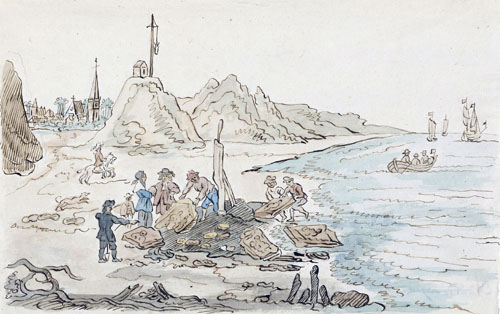 Illustration of the discovery of a Nehalennia temple in 1645 in Domburg, Netherlands, by A.C. Bonn, 1805 Illustration of the discovery of a Nehalennia temple in 1645 in Domburg, Netherlands, by A.C. Bonn, 1805 |
|
|
|
Post by pieter on Jan 13, 2022 16:06:25 GMT -7
 Modern statue of pre-Celtic fertility and mothergoddess Nehalennia, bronze, incorparated in the "Mondriaanbank" by Guido Metsers 1989, located Boulevard van Schagen Domburg view towards the south Modern statue of pre-Celtic fertility and mothergoddess Nehalennia, bronze, incorparated in the "Mondriaanbank" by Guido Metsers 1989, located Boulevard van Schagen Domburg view towards the south |
|
|
|
Post by pieter on Jan 13, 2022 16:12:44 GMT -7
Nehalennia Ron (Kai), Nehalennia is the most important regional deity we know in Zeeland in the South-Western corner of the Netherlands. She was an indigenous goddess, of Germanic origin, and was also venerated in Roman times. There was a temple dedicated to her near Domburg and one north of present-day Colijnsplaat. ( en.wikipedia.org/wiki/Domburg / en.wikipedia.org/wiki/Colijnsplaat ) Ron (Kai), Nehalennia is the most important regional deity we know in Zeeland in the South-Western corner of the Netherlands. She was an indigenous goddess, of Germanic origin, and was also venerated in Roman times. There was a temple dedicated to her near Domburg and one north of present-day Colijnsplaat. ( en.wikipedia.org/wiki/Domburg / en.wikipedia.org/wiki/Colijnsplaat )
The Roman era started in Zeeland shortly before the start of the era. In 53 BC the Menapians – the then inhabitants of Zeeland – surrendered to Julius Caesar, who wanted to conquer all of Gaul. For about a century, the North Sea coast was more or less the northwestern frontier of the Roman Empire. Until the Romans in 43 AD. conquered Britannia (present-day England). Zeeland would have been within the borders of the Roman Empire for more than 350 years. Nehalennia altar, erected by a salt merchant from Trier, according to the inscription. (National Museum of Antiquities, Leiden, South-Holland Province, the Netherlands)Seafood Nehalennia altar, erected by a salt merchant from Trier, according to the inscription. (National Museum of Antiquities, Leiden, South-Holland Province, the Netherlands)Seafood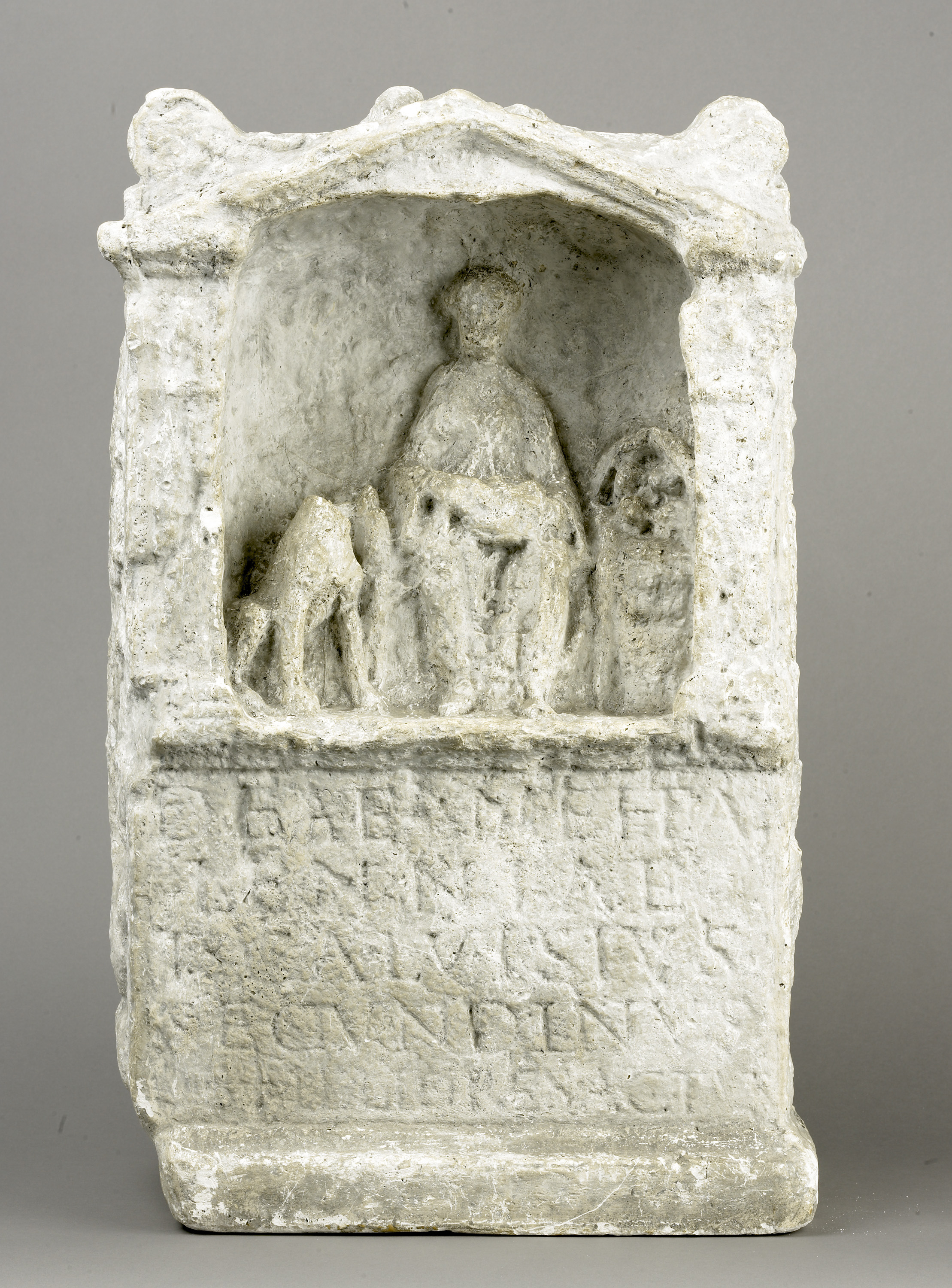 Nehalennia Votive StoneZeeland played an important role in overseas trade in Roman times. It was an important center for the production of salt, fish sauce and shellfish preserves. And at present-day Bergen op Zoom (North-Brabant) large-scale pottery was produced, including containers for fish and shellfish products. Based on this combination, Zeeland became a hub for international trade between Britannia, Gallia and the German hinterland. ( en.wikipedia.org/wiki/Bergen_op_Zoom ) Nehalennia Votive StoneZeeland played an important role in overseas trade in Roman times. It was an important center for the production of salt, fish sauce and shellfish preserves. And at present-day Bergen op Zoom (North-Brabant) large-scale pottery was produced, including containers for fish and shellfish products. Based on this combination, Zeeland became a hub for international trade between Britannia, Gallia and the German hinterland. ( en.wikipedia.org/wiki/Bergen_op_Zoom )
Ports and trade
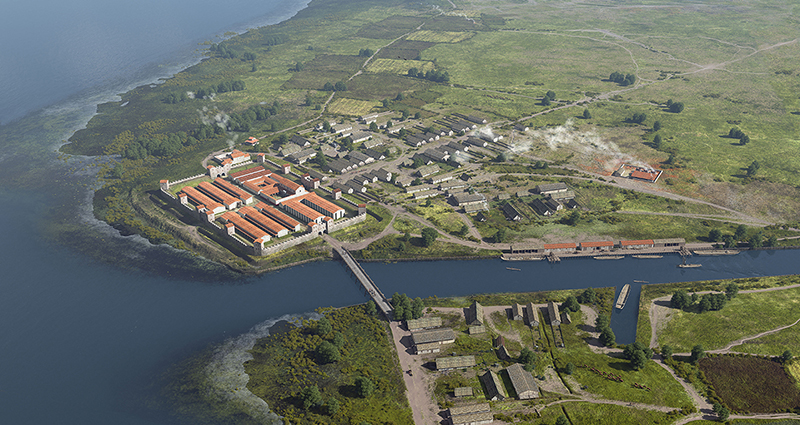
Reconstruction of the Roman sea port at Colijnsplaat in the Dutch Province of Zeeland [Credit: © Mikko Kriek] ( Source: archaeologynewsnetwork.blogspot.com/2016/03/roman-coast-at-national-museum-of.html )
Roman ports and trading places arose at Domburg and Colijnsplaat around 150 A.D. C. there were temples here for Nehalennia, a goddess who was worshiped exclusively at the Scheldt estuary at that time. Numerous traders, shipowners, administrators and soldiers from, among others, Cologne, Trier, Nijmegen, Tongeren and Northern and Central Gaul had altars placed here for Nehalennia. This shows how extensive the trade network of which Zeeland was part was. The finds of pottery from countries such as Britannia, Rhineland and Gaul also point to this.
Military bases

A Roman military base in the Roman occupied part of the Netherlands, the Southern half of the Netherlands, above the Rhine rivers the Germanic tribes ruled
In military terms, the Romans also left their mark. They set up military bases, presumably on the north bank of *the Oosterschelde (Eastern Scheldt) near the former work island of Roggenplaat (Roompot) and on the north side of Walcheren near Oostkapelle/Oranjezon. In Aardenburg around 170 AD. C. built a castellum, a military fortress. The castellum was partly intended to protect the North Sea coast and the trading ports. (* en.wikipedia.org/wiki/Eastern_Scheldt )  Statue of Nehalennia. It was fished up in parts near Colijnsplaat in 1970 and 1971. (National Museum of Antiquities, Leiden, South-Holland Province, the Netherlands)Protectress Statue of Nehalennia. It was fished up in parts near Colijnsplaat in 1970 and 1971. (National Museum of Antiquities, Leiden, South-Holland Province, the Netherlands)Protectress Nehalennia (spelled variously) is a goddess. Of unclear origin, perhaps Germanic or Celtic, Nehalennia is attested on and depicted upon numerous votive altars discovered around what is now the province of Zeeland, the Netherlands, where the Rhine River flowed into the North Sea. Worship of Nehalennia dates back at least to the 2nd century BC, and veneration of the goddess flourished in the 2nd and 3rd centuries AD. Nehalennia is attested on 28 inscriptions discovered in the Dutch town of Domburg on the Walcheren Peninsula in the Zeeland province in the South-West of the Netherlands.The goddess Nehalennia was the protectress of persons and matters related to shipping and trade. Skippers and traders left with their ships from present-day Domburg and Colijnsplaat. Usually they had Great Britain or the coast of France as their final destination. Before their departure, they turned to Nehalennia to take out some sort of insurance contract for safe navigation. They promised the goddess a gift, often in the form of an altar or votive stone, if they returned safely. It was then placed near the temple. Nehalennia (spelled variously) is a goddess. Of unclear origin, perhaps Germanic or Celtic, Nehalennia is attested on and depicted upon numerous votive altars discovered around what is now the province of Zeeland, the Netherlands, where the Rhine River flowed into the North Sea. Worship of Nehalennia dates back at least to the 2nd century BC, and veneration of the goddess flourished in the 2nd and 3rd centuries AD. Nehalennia is attested on 28 inscriptions discovered in the Dutch town of Domburg on the Walcheren Peninsula in the Zeeland province in the South-West of the Netherlands.The goddess Nehalennia was the protectress of persons and matters related to shipping and trade. Skippers and traders left with their ships from present-day Domburg and Colijnsplaat. Usually they had Great Britain or the coast of France as their final destination. Before their departure, they turned to Nehalennia to take out some sort of insurance contract for safe navigation. They promised the goddess a gift, often in the form of an altar or votive stone, if they returned safely. It was then placed near the temple.
Temple

An altar of the goddess Nehalennia from the Oosterschelde. Shown here with a dog, a fruit basket, and a ship, Nehalennia was a goddess of fertility, trade, and navigation.
A Nehalennia temple probably consisted of a fenced or walled space with a square temple inside. The stone altars were placed along the outer walls or in the grounds of the temple. Never in the temple. Just like entering into the contract with the goddess, its redemption (placement of the altar) was accompanied by ceremonies, including the making of sacrifices.
Altars
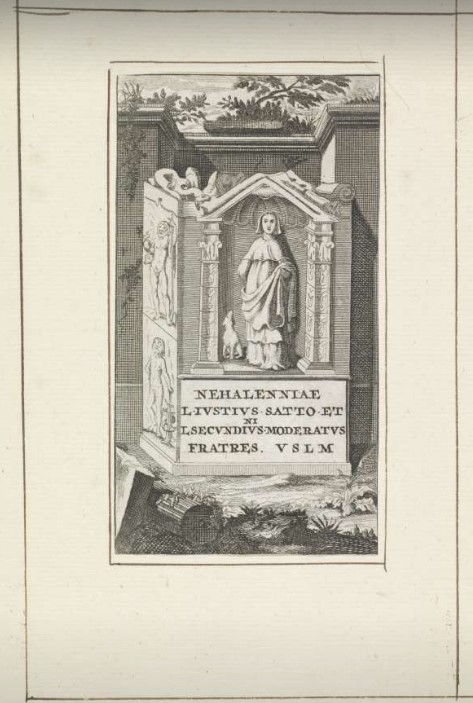
Nehallenia altar with Nehallenia standing with her dog, anonymous 1715
The altars came in all kinds of variants: from small and simple to large and richly decorated with sculpture and painting. On some the goddess is not depicted, on others it is. Most of the altars were made in the vicinity of the temples themselves. But another part was made in the vicinity of Tongeren in Belgium. Altar depicting Nehalennia standing with her left foot on the prow of a ship. (National Museum of Antiquities, Leiden, South-Holland Province, the Netherlands)Nehalennia was usually depicted sitting, often with a dog and a basket of fruit next to her. The dog here is a symbol of fidelity, vigilance and protection, the fruits the sign of fertility and prosperity. Altar depicting Nehalennia standing with her left foot on the prow of a ship. (National Museum of Antiquities, Leiden, South-Holland Province, the Netherlands)Nehalennia was usually depicted sitting, often with a dog and a basket of fruit next to her. The dog here is a symbol of fidelity, vigilance and protection, the fruits the sign of fertility and prosperity.
The origin of the name Nehalennia is most likely Germanic and then means 'the goddess who dwells by the water'.RemainsRoman rule in Zeeland ended shortly after the year 400, but the area was virtually depopulated earlier because the landscape drowned and became a Wadden region. Nehalennia disappeared into oblivion.
Remains of the Nehalennia worship have only been found in Zeeland. The goddess was not known anywhere else in the Roman Empire.
Due to erosion of the dunes near Domburg, the remains of a temple and 26 altars emerged for the first time in 1647. And in the seventies of the 20th century, a fishing vessel and divers at Colijnsplaat retrieved about 330 altars and altar fragments from the water. The reconstructed Nehalennia temple in Colijnsplaat. (Image bank SCEZ)The goddess is now omnipresent as a Zeeland symbol. In Colijnsplaat there is a reconstructed Roman temple that is dedicated to her. On the beach of Domburg, a modern statue of the goddess overlooks the sea and we come across her name in many places. In 2013, the book Nehalennia, the last sacrifice, written by Martinus de Kam, was published, intended for everyone from 12 years old.LiteratureRobert van Dierendonck, Roman times, in: Paul Brusse and Peter Henderikx (eds.), History of Zeeland, part 1: Prehistory – 1550, Zwolle/Utrecht 2012, 42-55. The reconstructed Nehalennia temple in Colijnsplaat. (Image bank SCEZ)The goddess is now omnipresent as a Zeeland symbol. In Colijnsplaat there is a reconstructed Roman temple that is dedicated to her. On the beach of Domburg, a modern statue of the goddess overlooks the sea and we come across her name in many places. In 2013, the book Nehalennia, the last sacrifice, written by Martinus de Kam, was published, intended for everyone from 12 years old.LiteratureRobert van Dierendonck, Roman times, in: Paul Brusse and Peter Henderikx (eds.), History of Zeeland, part 1: Prehistory – 1550, Zwolle/Utrecht 2012, 42-55.
G. Neumann & P. Stuart, Nehalennia, in: Reallexikon der Germanischen Altertumskunde2 XXI, Berlin/New York 2002, 61-65.
P. Stuart & J.E. Bogaers (+) 2001, Nehalennia; römische Steindenkmäler aus der Oosterschelde bei Colijnsplaat, I. Textband, II. Table band, Leiden (Collections of the National Museum of Antiquities at Leiden XI) 2001.
P. Stuart, Nehalennia van Domburg; history of the stone monuments, 1. Text binding, 2. Images, Utrecht 2013.
Most of the found altar stones and statues of Nehalennia are kept and exhibited in the National Museum of Antiquities in Leiden. A number of altars are also preserved in the Zeeuws Museum.Source: www.zeeuwseankers.nl/verhaal/nehalennia-1 (Translated by Pieter with Google translate)
|
|
|
|
Post by pieter on Jan 13, 2022 17:11:43 GMT -7
Wedding at the Nehalennia Temple in Coolijnsplaat, Zeeland, the Netherlands
|
|
|
|
Post by pieter on Jan 13, 2022 17:15:16 GMT -7
The Temple of Nehalennia in Colijnsplaat. Unfortunately the video is in Dutch.
Colijnsplaat is a town in the Province of Zeeland, the Netherlands It is a part of the Municipality of Noord-Beveland, and lies about 20 km (12 mi) northeast of Middelburg.
In 2005, a replica was installed here of a temple devoted to the prehistoric goddess Nehalennia, which remains had been found near the lost town of Ganuenta.[3] She is believed to have been of Germanic or Celtic origin, and there was active worship of her in this area in the 2nd and 3rd centuries AD, based on archeological finds. This replica temple is based on sanctuaries found at Roman provinces of Gaul and Germania. It was constructed, as much as possible, with authentic materials.
|
|
|
|
Post by pieter on Jan 14, 2022 7:12:48 GMT -7
 Nehalennia, Goddess of the Lowlands Nehalennia, Goddess of the Lowlands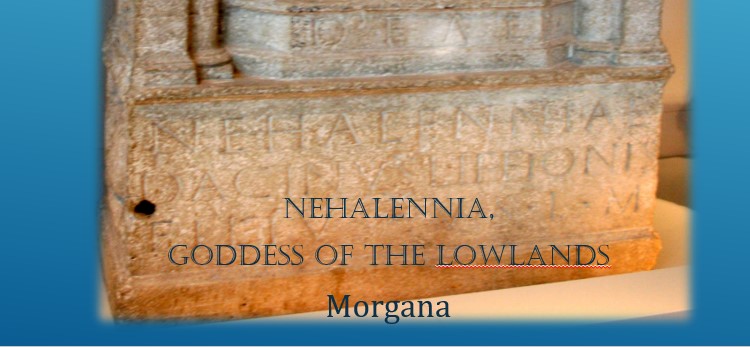 Recently, in the 1970’s, many Nehalennia votives washed up from the waters of Zeeland. Although she is by far the most famous indigenous goddess of the Netherlands – no fewer than 370 altars, statues and figurines of hers have having emerged – she is virtually unknown. Her name never made it into Dutch national history, or school books. Thankfully in the 1990’s there was a renewed interest in Nehalennia. In this presentation Morgana will be citing some of the research work done and her own observations. Hail Nehallenia!Who was Nehalennia? Nehalennia is known from more than 370 votive altars, which were almost all discovered in the Dutch province of Zeeland. (Two altars were also discovered in Cologne, the capital of Germania Inferior.) All of them can be dated to the second and early third centuries CE. Recently, in the 1970’s, many Nehalennia votives washed up from the waters of Zeeland. Although she is by far the most famous indigenous goddess of the Netherlands – no fewer than 370 altars, statues and figurines of hers have having emerged – she is virtually unknown. Her name never made it into Dutch national history, or school books. Thankfully in the 1990’s there was a renewed interest in Nehalennia. In this presentation Morgana will be citing some of the research work done and her own observations. Hail Nehallenia!Who was Nehalennia? Nehalennia is known from more than 370 votive altars, which were almost all discovered in the Dutch province of Zeeland. (Two altars were also discovered in Cologne, the capital of Germania Inferior.) All of them can be dated to the second and early third centuries CE.
Zeeland certainly has two Nehalennia temples, one was found near Domburg and Colijnsplaat. It is suspected that a third temple was located near Haamstede near Westerschouwen on Schouwen-Duiveland. It is probable that there have been many more sunken temples and have stretched as far as England.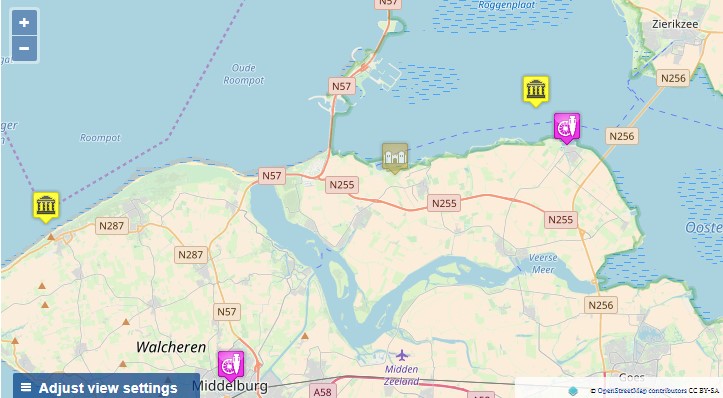 Map of Zeeland showing the location of the 2 ancient Nehallenia templesThe first temple is located in Roman times directly on the coast near Domburg on Walcheren. There used to be a cove in the high dunes. This was a kind of seaport for the Roman fleet. There was the temple on a high dune in the middle of a kind of forest near a freshwater source. A storm in 1647 exposed the foundations on the beach at Domburg, bordered by tree stumps. Today, the foundations of the temple lie far out to sea and are covered by sand and seawater. Map of Zeeland showing the location of the 2 ancient Nehallenia templesThe first temple is located in Roman times directly on the coast near Domburg on Walcheren. There used to be a cove in the high dunes. This was a kind of seaport for the Roman fleet. There was the temple on a high dune in the middle of a kind of forest near a freshwater source. A storm in 1647 exposed the foundations on the beach at Domburg, bordered by tree stumps. Today, the foundations of the temple lie far out to sea and are covered by sand and seawater.
The second temple is located off the coast near the village of Colijnsplaat on Noord-Beveland. Where the water of the current Oosterschelde now flows, there was a Roman village with a river port, called Ganuenta; the village with temple already at the end of the 4th century AD. Which was later swallowed by the Scheldt. It was not until 1971 that a fishing vessel fished out the first altars. After this huge find, there were hundreds of dives.
One had to wait for the Spring tides when the strong current washes away the sand from the temples. Then one has to dive 25 meters deep to find the foundations of the sunken temple.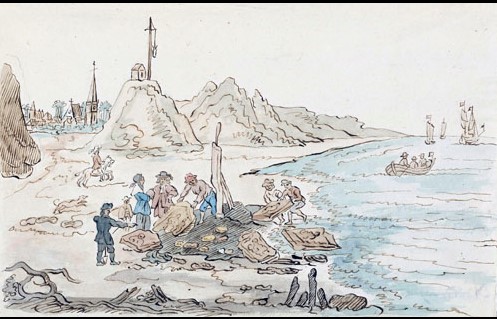 The discovery of a Nehalennia temple in Domburg. 19th Century drawing after a sketch from 1647All the donors of the 370 Nehalennia votive altars are men, according to the Latin inscriptions on the altars. On this they have themselves immortalized, always by name and surname. Sometimes they also state their profession, merchandise and origin. They are mainly skippers, shipowners and merchants. The discovery of a Nehalennia temple in Domburg. 19th Century drawing after a sketch from 1647All the donors of the 370 Nehalennia votive altars are men, according to the Latin inscriptions on the altars. On this they have themselves immortalized, always by name and surname. Sometimes they also state their profession, merchandise and origin. They are mainly skippers, shipowners and merchants.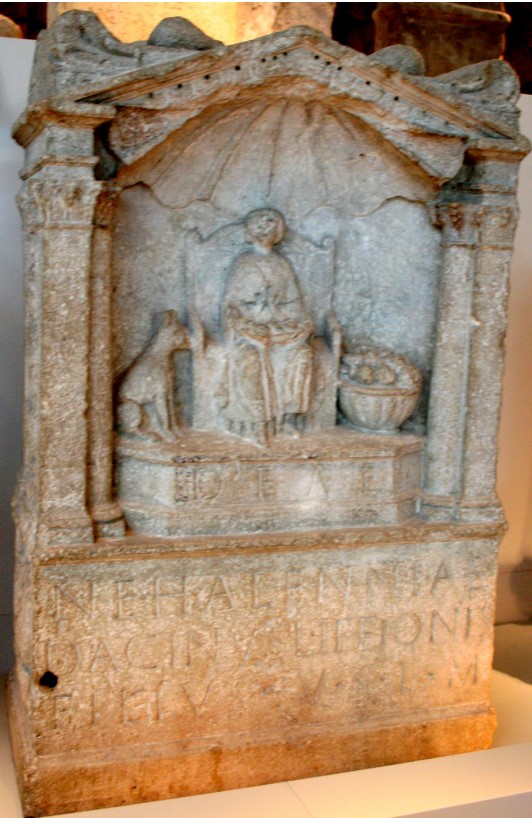 A Nehalennia votive – RMO / Museum of Antiquities Leiden A Nehalennia votive – RMO / Museum of Antiquities Leiden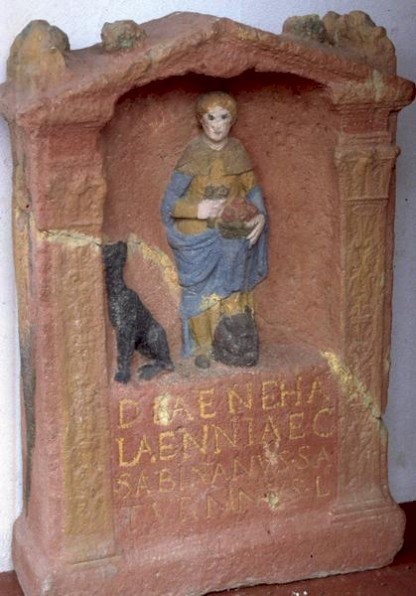 Reconstruction of a dedication to Nehalennia – they were most certainly colouredSeveral inscriptions inform us that the votive altar was placed to show gratitude for a safe passage across the North Sea, and we may assume that other altars were dedicated for the same reason. (Of course, this does not mean that all pieces were erected after a safe passage.) An example of a typical inscription:To the goddess Nehalennia, Reconstruction of a dedication to Nehalennia – they were most certainly colouredSeveral inscriptions inform us that the votive altar was placed to show gratitude for a safe passage across the North Sea, and we may assume that other altars were dedicated for the same reason. (Of course, this does not mean that all pieces were erected after a safe passage.) An example of a typical inscription:To the goddess Nehalennia,
on account of goods duly kept safe,
Marcus Secundinius Silvanus,
trader in pottery with Britain,
fulfilled his vow willingly and deservedly.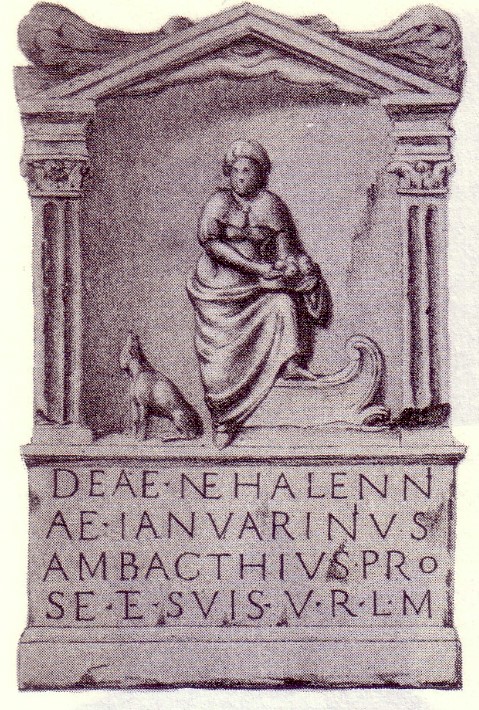 Inscription: SE ET SUIS VOTUM RESOLVIT LIBENS MERITO Inscription: SE ET SUIS VOTUM RESOLVIT LIBENS MERITO  Nehallenia altar with Nehallenia standing with her dog, anonymous 1715Where did the name Nehallenia come from? The name only became known when the votives were washed up near to Colijnsplaat, January 5, 1647. Other statues were also found depicting amongst others Neptune. This seems to reinforce the idea that this area round Domburg was an important holy site for the Romans. The statues, votives and altars were housed in the Church in Domburg. Unfortunately, many were destroyed in the fire of 1848. Luckily, many sketches of the votives had been made and the inscriptions – in Latin – are quite clear. Nehallenia altar with Nehallenia standing with her dog, anonymous 1715Where did the name Nehallenia come from? The name only became known when the votives were washed up near to Colijnsplaat, January 5, 1647. Other statues were also found depicting amongst others Neptune. This seems to reinforce the idea that this area round Domburg was an important holy site for the Romans. The statues, votives and altars were housed in the Church in Domburg. Unfortunately, many were destroyed in the fire of 1848. Luckily, many sketches of the votives had been made and the inscriptions – in Latin – are quite clear.
According to the most recent theory, the roots are in Welsh. Through Celtic, Nehalennia can be traced back to ‘she who is by the sea’.
According to the theory from Patrizia Bernardo de Stempel (2004), she states that Nehalennia is strongly connected to the sea and that it is therefore possible that her name reflects this fact. In addition, the name Nehalennia always occurs as an addition with a preceding dea, the Latin word for goddess. So it is likely that Nehalennia acts as an extra explanation to dea and tells about the kind of goddess we are dealing with. This suspicion is reinforced by a number of inscriptions where the name appears in the plural, namely deae nehalenniae.
Bernardo de Stempel mainly finds traces in Welsh, with words such as halein ‘salt’ and heli ‘sea’. These words allow for a Late Celtic reconstruction *halen– meaning ‘sea’ which together with a prefix *ne- (meaning ‘on’ and ‘at’) would form the basis for the name Nehalennia. The word formation is then structured as follows; first the prefix *ne- (= by), then the middle part *-halen- (= sea) and finally the suffix *-ja which makes feminine derivations; taken together, the name would then mean “she who is by the sea”.
Annine van der Meer: “Nehalennia has a clear relationship with the water. She stands with one foot on the bow of a ship; when she sits, she sometimes is holding marine parts. This makes her the helmsman, guide and patroness of the skippers who sail from Zeeland across the North Sea. Through the waters there is also a connection to the underworld, with the land of the goddess Helle or Holle, who gave her name to the Hollow Land or Cave Land. Nehalennia also has a connection with the underworld, as evidenced by the symbol of the dog next to her. The symbols prove that Nehalennia has three spheres of influence: the upper world, the earth world and the underworld. This makes her a ‘Mother Goddess’. She is rooted in the earth, in the land of the ancestors. Now she appears to be an ancient and pre-Celtic Mother Goddess from pre-patriotic, yes motherland times.”
In any event it seems as though the name ‘Nehallenia’ is specific to this region.Annine further writes:“The visual language of NehalenniaWhen you approach Nehalennia from a female perspective, you get an eye for the iconography of the goddess, for her imagery on the altars, which has a deeply symbolic meaning. The Nehalennia iconography even takes on an international allure when you place it in the context of the well-known iconography of the ‘Mother Goddess’. That is quite different from the traditional view that considers ‘mother goddesses’ to be purely local and regional. In this view, the term ‘mother goddess’ is consciously written in lower case according to the convention. These homegrown ‘local’ goddesses rooted in the earth are considered of less importance than the ‘great’ Roman gods such as Jupiter, Neptune and Hercules. The Nehalennia altars show these ‘great’ gods as ‘partners’ of Nehalennia; they are common in the side panels and not in the foreground.
The visual language proves that Nehalennia has three spheres of influence. She is seated on a throne set up on a platform. Above her head there is the shell-shaped canopy. These are symbols of the upper world. In the terrestrial middle world she rules the life-giving force of nature and fertility. Numerous vegetation symbols serve this purpose. She always has a basket of fruits in her left hand. In her right hand she can hold a bunch of wheat stalks, vegetables or even a long steering oar or tiller. She is the helmsman who brings the ship safely across the waters. There are other symbols for the underworld. Near her left foot is almost always a large basket of apples, possibly pomegranates, the fruits of the underworld. At her right foot is her faithful companion: the dog that often looks up to her. Together with this animal she guides the souls of the deceased across the waters of the afterlife to the other world. She gives birth to them in a new life and thus shows herself to be a real Mother who, even in a life after death, takes care of her children.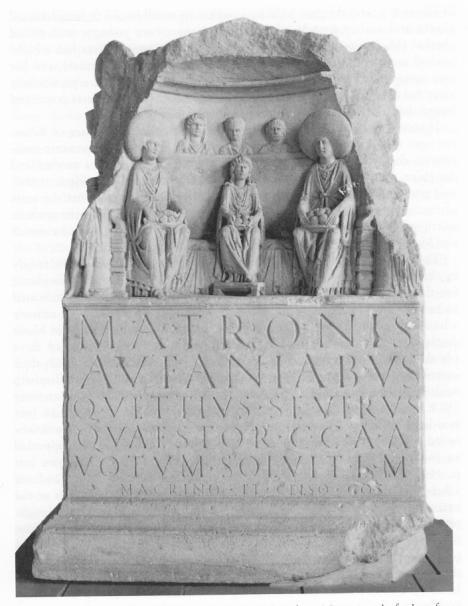 A matrons altar – Germany A matrons altar – Germany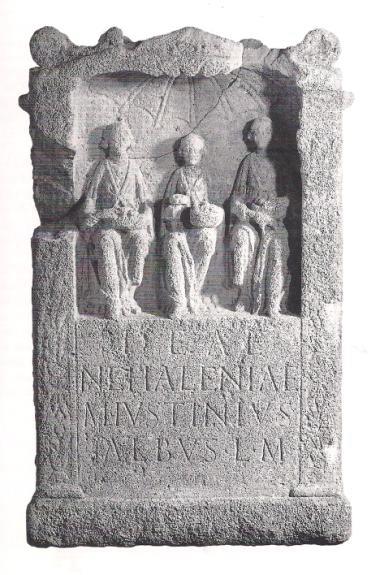 They are called the “Matrons” in Germany.Nehalennia appears on two altar stones in triplicate. In this she shows great resemblance to altar stones of three Mother Goddesses from Germany. They appear on no fewer than 850 altar stones. They are called the “Matrons” in Germany. There is a clear relationship between the triple Nehalennia or the three Nehalennias from Zeeland and the ‘Three Ladies from Germany’. They are called the “Matrons” in Germany.Nehalennia appears on two altar stones in triplicate. In this she shows great resemblance to altar stones of three Mother Goddesses from Germany. They appear on no fewer than 850 altar stones. They are called the “Matrons” in Germany. There is a clear relationship between the triple Nehalennia or the three Nehalennias from Zeeland and the ‘Three Ladies from Germany’.
On the Matrons altar you see a young girl or the Virgin sitting in the middle with loose hair that falls into a part: she represents the earth or the middle world. To her left is her Mother with a large balloon-shaped hat: she represents the sun or the upper world. To her right is her Grandmother, wearing the same balloon-shaped large hat, who represents the moon or the underworld.
What does this trinity mean? First, the goddesses symbolize the connection between the upper, middle and lower world, between sun, earth and moon. Secondly, the trinity can also indicate the changing of the terrestrial seasons in spring, summer, winter-new spring. Always the three goddesses symbolize the relationship between create-maintain-transform.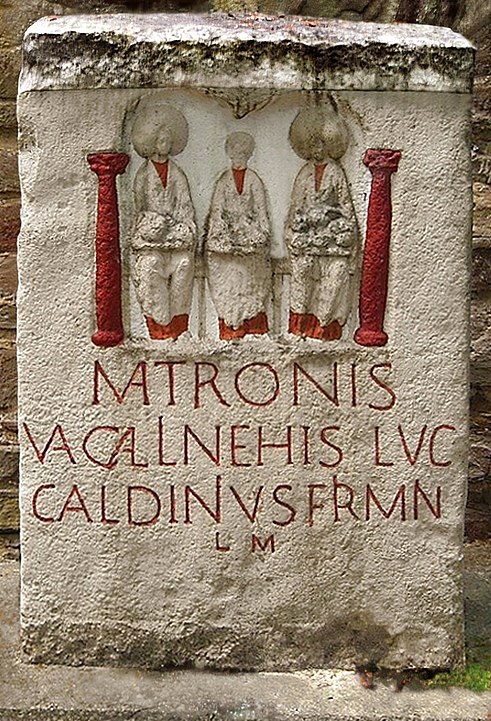 Foto: Mediatus, 30. Juni 2010, Wikimedia CCNehalennia and ‘The Three Ladies from Germany Foto: Mediatus, 30. Juni 2010, Wikimedia CCNehalennia and ‘The Three Ladies from Germany’ It is useful to connect ‘The Three Ladies from Germany’ with Nehalennia because they are all Mother Goddesses. This puts Nehalennia in a broader perspective; it grows above the local and regional framework of Zeeland. In the triangle of the German cities of Cologne, Bonn and Trier with the German Eifel at the heart of this triangle, as mentioned, 850 altars have been found dedicated to the Matrons so popular here. In contrast to the situation in Zeeland, ten percent of these was donated by a woman.
A third of the Matron altars bear the names of independent women, married couples and extended families. This is different with Nehalennia; on her altars you will find only the names of male donors. So precious altars have indeed been offered by women to Mother Goddesses outside Zeeland.Who are the Matrons?They are initially clan mothers of their own extended families. They are later deified into goddesses. As many as 100 honorary or nicknames related to local clan names were found on the inscriptions. In these clan names there is a clear connection with nature: the names that have to do with the water, the tree and the cow are the most common. Research in Germany at excavated Matron centres shows conclusively that the oldest Matron shrines are tree shrines that often lie next to flowing or standing water.
The visual language on the altars with many trees and branches also proves this. On the Matron altars, sacrificial servants and servants often stand with baskets full of fruit in front of tree shrines. These open-air shrines were not converted into stone temples with walls around them until later in Roman times. Only then are numerous sage altars offered. The Matrons are therefore clearly of pre-Roman origin.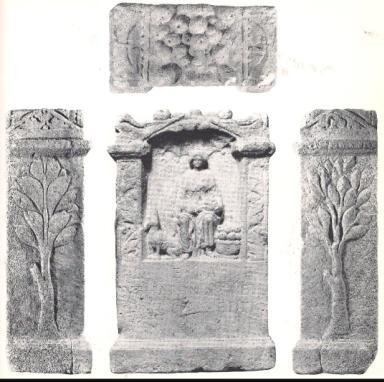 Nehallenia Matron TreeAmong the symbols on the altars, the following symbols are common: the tree of life, the fruits of the tree of life, the horn of plenty filled with fruits from the tree of life, and finally the serpent coiling around the tree of life. This applies to both the Nehalennia altars from Zeeland and the Matron altars from Germany. This symbolism indicates a paradisiacal situation of abundance provided by the goddesses. The old man experiences a great connection with nature. Hence, these people set up holy places or power places in the open air as places of gathering. Nehallenia Matron TreeAmong the symbols on the altars, the following symbols are common: the tree of life, the fruits of the tree of life, the horn of plenty filled with fruits from the tree of life, and finally the serpent coiling around the tree of life. This applies to both the Nehalennia altars from Zeeland and the Matron altars from Germany. This symbolism indicates a paradisiacal situation of abundance provided by the goddesses. The old man experiences a great connection with nature. Hence, these people set up holy places or power places in the open air as places of gathering.
Prior to the Roman period, Mother Goddesses are worshiped in the open air in the form of a tree or a wooden statue made from a sacred tree. You will find the shrines near springs welling up from the earth, fast-flowing rivers, as well as standing water near swamps. In particular, waters that well up from the earth, such as springs and subterranean rivers in caves, are experienced as very beneficial and fertile. In the perception of the ancients, they well up directly from the sacred subterranean world, the underworld, where the souls of the deceased reside.The ordinary women with sacrifices in kindWomen are known to offer in-kind products at temples. How do they get them? Well, they grow it themselves. The connection between women and the plant world is ancient. In the Ice Age, women collected food and gathered as much as 80 to 90% of the daily menu. This elicits the statement that it is better to speak of a gatherer-hunter culture rather than the other way around. After the Ice Age, women develop the first gardens and small fields in the transition from hunting and food-gathering to agriculture. Therefore, traditionally it is women who are engaged in gardening, agriculture and livestock; the men hunt and fish or trade, also in Roman Zeeland. The sea-going vessels must be supplied with foodstuffs, such as grain, dried meat and fruits. This supply is provided by the hinterland.
The Roman armies on the Rhine frontier and also in northern England need grain. There is evidence that in Zeeland from the 1st century AD, a new higher quality cultivated wheat has been harvested. That is why this new type is probably proudly depicted on the altars. Sometimes Nehalennia holds a bunch of grains or wheat in her right hand next to a basket of fruits in her left. Women’s work!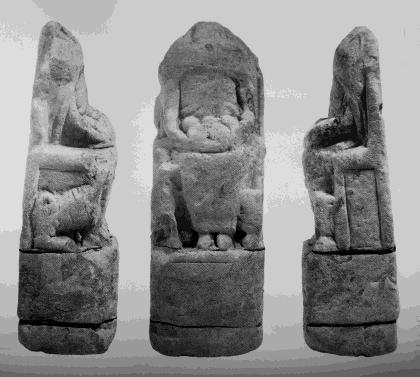 Offerings in kind… bread, fruit.Bread offeringsThe Nehalennia altars have a flat top on which are carved stone offerings, which last forever and do not perish. On top are apples and pears. Once you see a half sun with great outgoing rays, a bread offering. Bones of sacrificial animals are also depicted; baking their moulds into bread prevented the animals from having to be physically killed. Bread in this form is still baked north of Amsterdam as ‘Duivekater’. Probably the women before Nehalennia, as everywhere else, baked sacred bread in certain baking tins. Then they ate their baked goods together during a sacred meal and thus became one with the goddess. And home-made bread offerings are – in view of the baking tins that are found everywhere – a popular and cheap women’s offering internationally.Women offer small sacrificial statuesIn addition to 330 (parts of) altars, five small terracotta figurines or statuettes have surfaced in Ganuenta, a Roman settlement near to present day Colijnsplaat. Offering a small statuette is much, much cheaper than donating a large altar stone. The figurines are often made in workshops near temples. It has been estimated that the workshops in Central Gaul and Germany alone produced between 500,000 and 1 million figurines in the first three centuries of our era. A Matron researcher in Germany stated that at least 50% of goddesses with maternal or fertility properties exists. In the international context with the great majority of local female deities and their sacrificed art, this estimate seems on the meagre side. Offerings in kind… bread, fruit.Bread offeringsThe Nehalennia altars have a flat top on which are carved stone offerings, which last forever and do not perish. On top are apples and pears. Once you see a half sun with great outgoing rays, a bread offering. Bones of sacrificial animals are also depicted; baking their moulds into bread prevented the animals from having to be physically killed. Bread in this form is still baked north of Amsterdam as ‘Duivekater’. Probably the women before Nehalennia, as everywhere else, baked sacred bread in certain baking tins. Then they ate their baked goods together during a sacred meal and thus became one with the goddess. And home-made bread offerings are – in view of the baking tins that are found everywhere – a popular and cheap women’s offering internationally.Women offer small sacrificial statuesIn addition to 330 (parts of) altars, five small terracotta figurines or statuettes have surfaced in Ganuenta, a Roman settlement near to present day Colijnsplaat. Offering a small statuette is much, much cheaper than donating a large altar stone. The figurines are often made in workshops near temples. It has been estimated that the workshops in Central Gaul and Germany alone produced between 500,000 and 1 million figurines in the first three centuries of our era. A Matron researcher in Germany stated that at least 50% of goddesses with maternal or fertility properties exists. In the international context with the great majority of local female deities and their sacrificed art, this estimate seems on the meagre side.
In Germany, research has been done on 1000 statues in which places the small female statues have been found; of 70% it was possible to trace the location. About 33.5% has been found in temples or subterranean storage rooms of temples; 15.7% in houses and 14.9% in graves.
For the Netherlands it has been established that among the small terracotta statues and altarpieces the female deities are in the majority. It is here that the invisible women emerge, in large numbers. Women bond with their ‘local’ goddesses, seek their support and have sacrificed to them.
The temples and the temple staffWhat the sea took in the Netherlands has been rediscovered in Germany. At least ten sizable Matron Centres have been excavated here. The Matron Sanctuary on top of Mount Addig in Germany’s Eifel is located in an ancient forest; the mountain is surrounded by three streams. It is the sacred centre of the Celtic clan of the Vacalli or cowherds who inhabit the area around it. In this great sanctuary, which is called the ‘Pompeii of the Eifel’, the first large garden with the sacred tree appears. Later in Roman times a temple for the three Matrons was built there; in the temple there must have been a larger cult statue. There is also a common storage area for the grain. Finally, there is a collection house for clan. Processions are held in the covered pedestrian alley that surrounds the complex, so that the procession can continue in bad weather. Communal meals are also held after sacrifices have been made. Benches and podiums have been found that indicate that the assembly halls also had a theatrical function. Incubation rituals may also have taken place. People were cured through dreams or received clues to certain problems through visionary dreams. It is very likely that in these centres, where traditionally later deified clan mothers are worshiped in ceremonial clothing, their female progeny also serves. On the altars, the ladies wear the same ceremonial clothing as their deified Matron foremothers. These ladies are more than mere wives of the gentlemen sacrificer’s. Some are depicted alone with their top round hats while sacrificing. They can therefore be priestesses.Prophesying and shamanizing.Of the 834 Matron inscriptions on pointers, 116 have been found that contain a revelation inscription. The stones were donated by the donors after the goddesses revealed themselves in a vision or in a dream. This indicates direct contact between the goddesses and their followers.
Three revelation inscriptions have also been found on the 370 keys of Nehalennia that have been recovered. Altars of twelve early Germanic goddesses have been found that stood in open-air sanctuaries. Jan de Vries and Kees Samplonius assume that all these twelve goddesses from Dutch soil were oracled. Prophecy and oracles have traditionally been a specialism of women, of ‘wise women’. It is certain that both the Celts, the Romans like the Teutons had respect for the prophetic and healing gifts of wise women. Their influence was great because with their visionary powers they helped the people and healed them. Also in the temples of Nehalennia in her aspect of goddess of the underworld, priestesses who represent her must have argued: it is a new and for me unexpected aspect that finally resurfaces with Nehalennia. We have rediscovered the Pythias from our own soil.”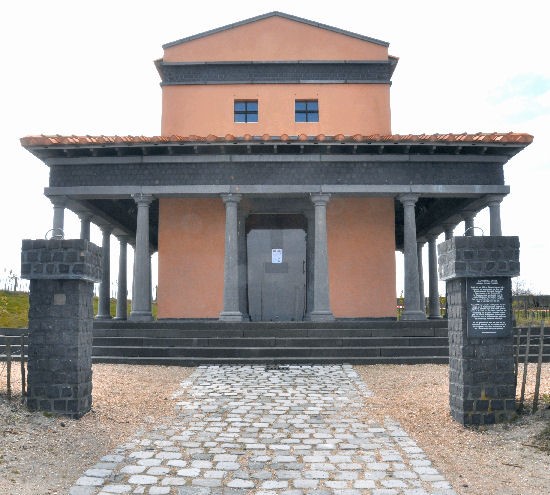 The temple… A modern reconstructionThe Nehalennia Temple has been reconstructed after an example from the time of the Romans and the Celts. The copy is located on the banks of the Oosterschelde National Park in the Zeeland village of Colijnsplaat. This historic monument is a replica of a sanctuary that stood in that area between 150 and 250 AD. At the time, it was much visited by traders from north western Europe. The building is intended as a tangible sign of a past completely forgotten up to half a century ago. Since its opening in 2005, the Nehalennia temple has grown into a tourist attraction in Noord-Beveland and a well-known icon in Zeeland. The replica has gained widespread recognition as the second window in the official canon of Zeeland. In addition, for many visitors the temple is a special place for contemplation and spirituality. The temple… A modern reconstructionThe Nehalennia Temple has been reconstructed after an example from the time of the Romans and the Celts. The copy is located on the banks of the Oosterschelde National Park in the Zeeland village of Colijnsplaat. This historic monument is a replica of a sanctuary that stood in that area between 150 and 250 AD. At the time, it was much visited by traders from north western Europe. The building is intended as a tangible sign of a past completely forgotten up to half a century ago. Since its opening in 2005, the Nehalennia temple has grown into a tourist attraction in Noord-Beveland and a well-known icon in Zeeland. The replica has gained widespread recognition as the second window in the official canon of Zeeland. In addition, for many visitors the temple is a special place for contemplation and spirituality.
The Nehallenia Temple has been incorporated in the Canon of Zeeland.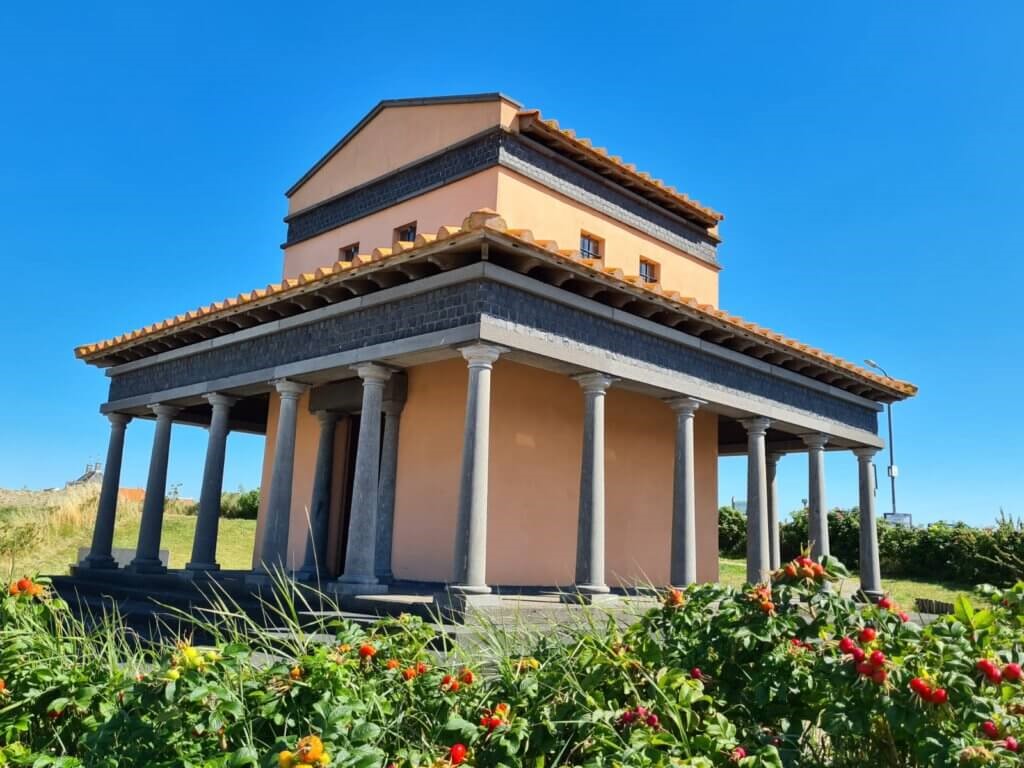 Colijnsplaat, reconstructed temple of NehalenniaReconstruction of the temple, Colijnsplaat / Reconstructie van de tempel op ColijnsplaatDuring the 1970’s more artefacts were found. However only wood and roof tiles were found but no pillars / columns. With only wood for supports this would be the general construction: Colijnsplaat, reconstructed temple of NehalenniaReconstruction of the temple, Colijnsplaat / Reconstructie van de tempel op ColijnsplaatDuring the 1970’s more artefacts were found. However only wood and roof tiles were found but no pillars / columns. With only wood for supports this would be the general construction: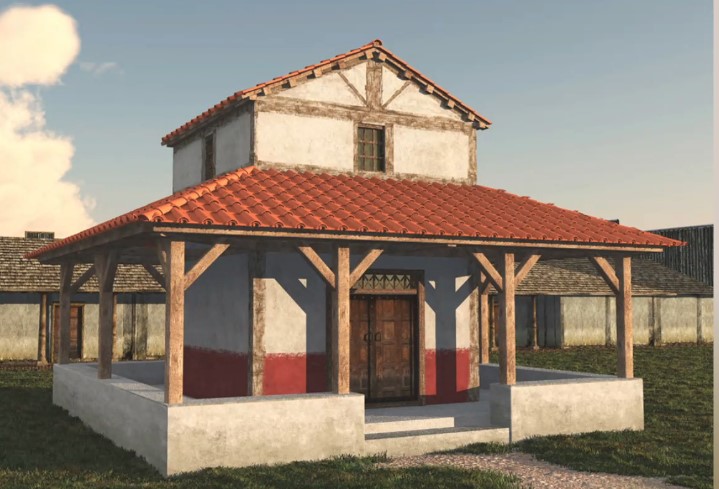 Impression with wooden supports by Mikko Kriek Impression with wooden supports by Mikko Kriek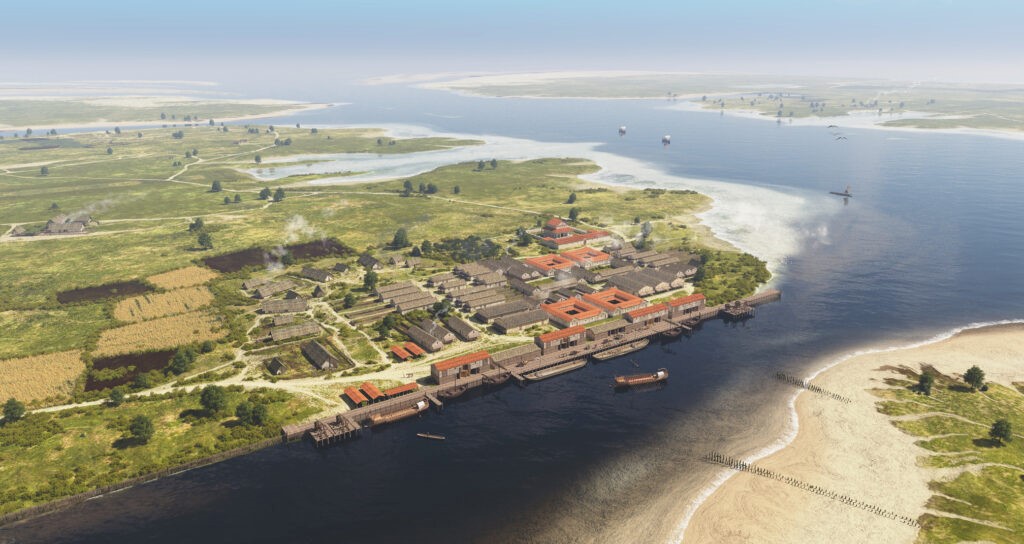 Roman harbour of Ganuenta (180-230 AD) painting by Mikko KriekAlso from Mikko Kriek: a painting of how the Roman harbour of Ganuenta (180-230 AD) could have looked like.Building the templeThe temple building was commissioned by the Nehalennia foundation and designed by architect Henk Zandee. Archaeological draftsman Harry Burgers of the Free University of Amsterdam provided information about Roman architecture and Celtic geometry. It was realized under the supervision of client Jan Rolloos. Pupils from the school community Nehalennia in Middelburg have made the beautiful oak roof in a traditional and traditional way under the guidance of teacher Wim Mulder. Colleague Bram Slabbekoorn installed the electricity. In addition, the school community donated a successful modern version of a statue of the goddess, made by teacher Hans Zuidema. This is placed against the left inner wall. Roman harbour of Ganuenta (180-230 AD) painting by Mikko KriekAlso from Mikko Kriek: a painting of how the Roman harbour of Ganuenta (180-230 AD) could have looked like.Building the templeThe temple building was commissioned by the Nehalennia foundation and designed by architect Henk Zandee. Archaeological draftsman Harry Burgers of the Free University of Amsterdam provided information about Roman architecture and Celtic geometry. It was realized under the supervision of client Jan Rolloos. Pupils from the school community Nehalennia in Middelburg have made the beautiful oak roof in a traditional and traditional way under the guidance of teacher Wim Mulder. Colleague Bram Slabbekoorn installed the electricity. In addition, the school community donated a successful modern version of a statue of the goddess, made by teacher Hans Zuidema. This is placed against the left inner wall.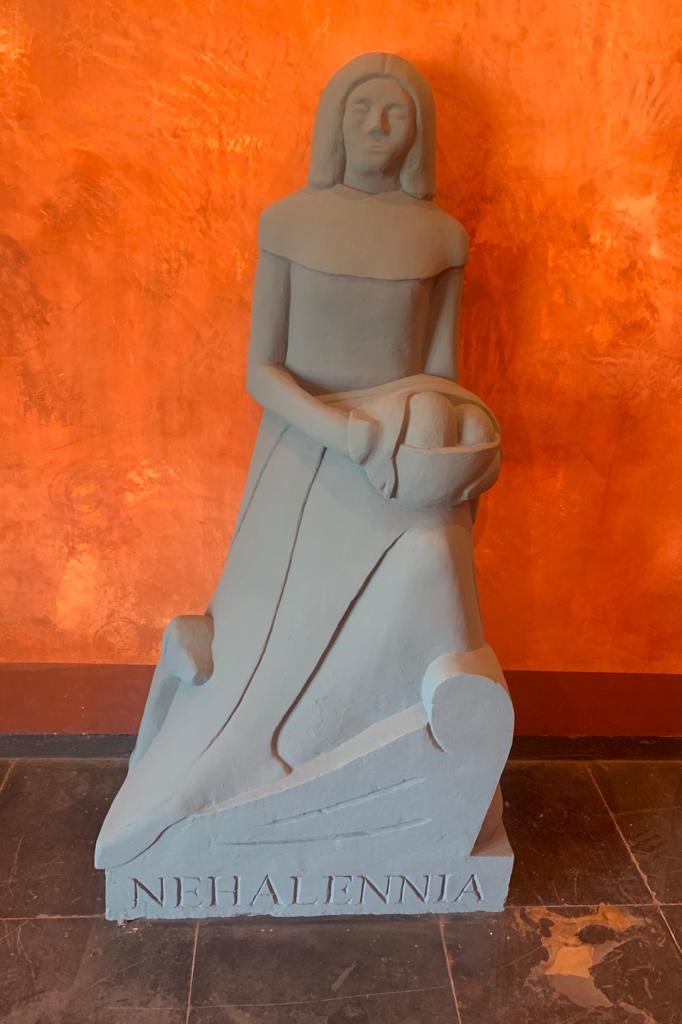 A modern statue of the Goddess Nehallenia A modern statue of the Goddess Nehallenia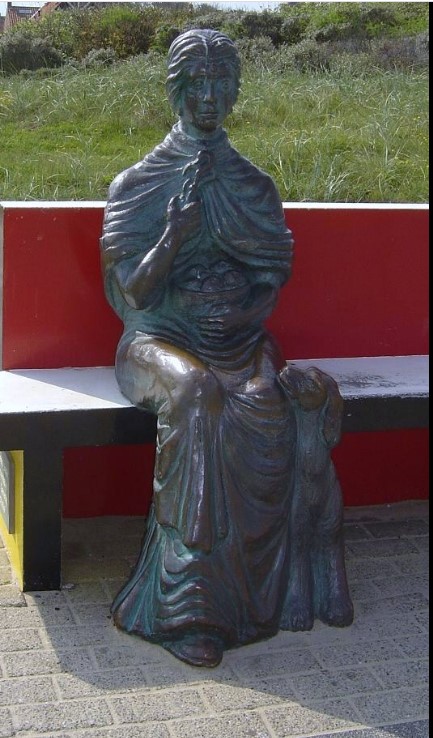 A modern sculpture of Nehallenia in Domburg (Zeeland) made by sculpturist Guido Metsers. Nehalennia in bronze. Guido Metsers 1989 – many people sit next to her on the bench and have their photo taken.In the Themepark Archeon, there is a reconstructed Roman temple – based on one from Cuijk – near the roman town of Novio Magus, modern day Nijmegen. This temple is currently used for parties, especially Wedding Feasts, and often called the ‘Nehallenia Temple’. A modern sculpture of Nehallenia in Domburg (Zeeland) made by sculpturist Guido Metsers. Nehalennia in bronze. Guido Metsers 1989 – many people sit next to her on the bench and have their photo taken.In the Themepark Archeon, there is a reconstructed Roman temple – based on one from Cuijk – near the roman town of Novio Magus, modern day Nijmegen. This temple is currently used for parties, especially Wedding Feasts, and often called the ‘Nehallenia Temple’.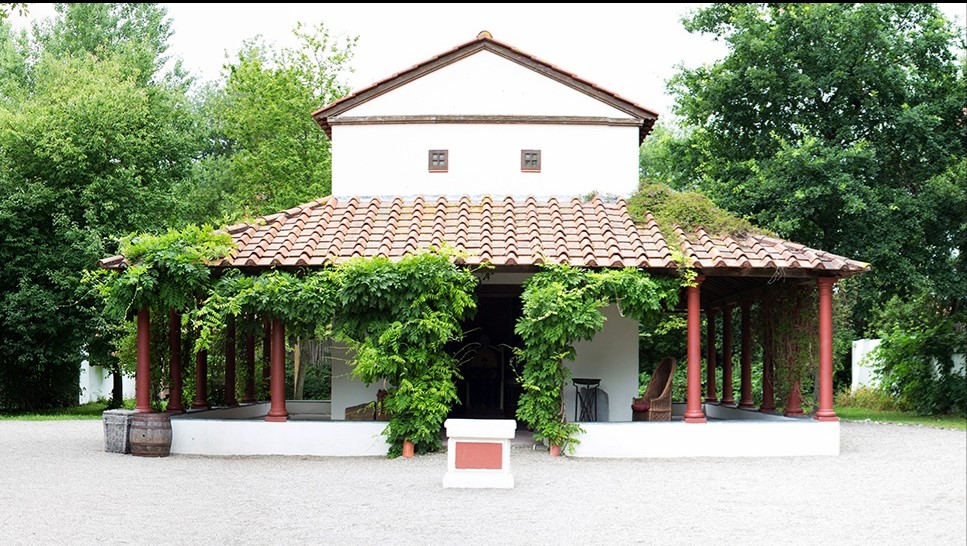 The ‘Nehallenia Temple’ in the Archeon Museum Park in Alphen aan den Rijn in South-Holand, the Netherlands The ‘Nehallenia Temple’ in the Archeon Museum Park in Alphen aan den Rijn in South-Holand, the Netherlands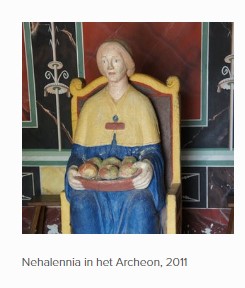 Merchants from Trier?In 2019 Annine van der Meer visited the amazing Gallo-Roman temple in the district of Metzenberg. municipality of Tawern, near to Trier. It was built in the 1st century AD at about the same time as the Nehallenia temples. Merchants from Trier?In 2019 Annine van der Meer visited the amazing Gallo-Roman temple in the district of Metzenberg. municipality of Tawern, near to Trier. It was built in the 1st century AD at about the same time as the Nehallenia temples.
Here are some of the photos Annine took.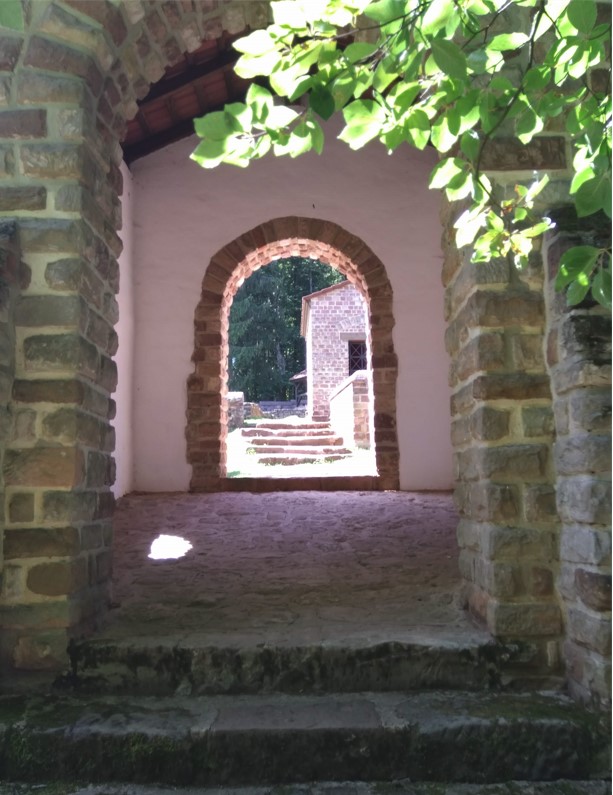 Gallo-Roman temple municipality of Tawern, near to Trier, Germany- photo MorganaThe names of the persons who gifted the statues and altars to Nehallenia show they were merchants from Italy, Cologne, Trier and Britannia. They traded in salt, fish sauce and textiles. Other wares were ceramics from the area around the Rhine, terracotta figurines from Cologne and Trier, and wine from Southern France and the Mosel-area. One inscription found translates to: “Before Nehalennia, Marcus Exingius Agricola, citizen of Trier, salt merchant in Cologne, has fulfilled his promise, willing and with reason”. Gallo-Roman temple municipality of Tawern, near to Trier, Germany- photo MorganaThe names of the persons who gifted the statues and altars to Nehallenia show they were merchants from Italy, Cologne, Trier and Britannia. They traded in salt, fish sauce and textiles. Other wares were ceramics from the area around the Rhine, terracotta figurines from Cologne and Trier, and wine from Southern France and the Mosel-area. One inscription found translates to: “Before Nehalennia, Marcus Exingius Agricola, citizen of Trier, salt merchant in Cologne, has fulfilled his promise, willing and with reason”.
The temple is dedicated to Mercury, God of trade, so it would be reasonable to think there was a link with this temple and that of Nehallenia. There is a modern statue of Mercury, complete with various attributes, now in the temple.
Trier was a Roman town founded in the 1st Century AD and is situated on the River Moselle, which flows into the River Rhine at Koblenz. The Rhine flows further into the Netherlands and is one of the big rivers forming the Delta in the West of the country.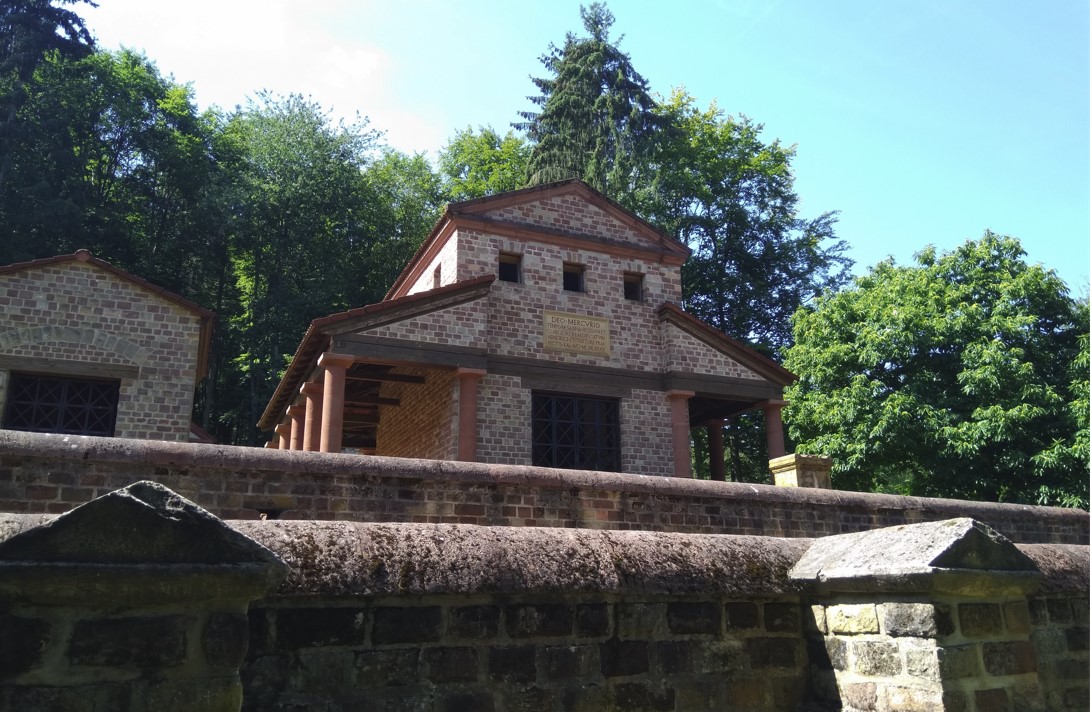 Nehallenia Trier Temple of Mercury Nehallenia Trier Temple of Mercury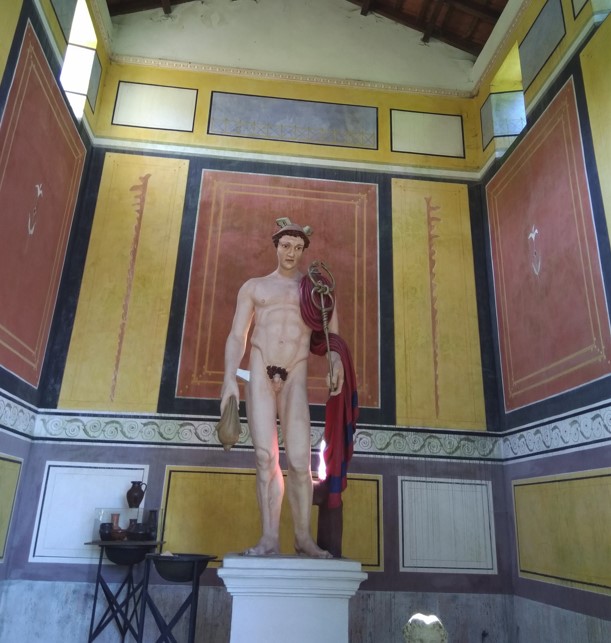 A modern statue of Mercury is in the temple now. – photo MorganaThe temple was also dedicated to Epona who “was a protector of horses, ponies, donkeys, and mules. She was particularly a goddess of fertility, as shown by her attributes of a patera, cornucopia, ears of grain and the presence of foals in some sculptures. She and her horses might also have been leaders of the soul in the after-life ride, with parallels in Rhiannon of the Mabinogion. The worship of Epona, ’the sole Celtic divinity ultimately worshipped in Rome itself’, as the patroness of cavalry, was widespread in the Roman Empire between the first and third centuries AD; this is unusual for a Celtic deity, most of whom were associated with specific localities”. A modern statue of Mercury is in the temple now. – photo MorganaThe temple was also dedicated to Epona who “was a protector of horses, ponies, donkeys, and mules. She was particularly a goddess of fertility, as shown by her attributes of a patera, cornucopia, ears of grain and the presence of foals in some sculptures. She and her horses might also have been leaders of the soul in the after-life ride, with parallels in Rhiannon of the Mabinogion. The worship of Epona, ’the sole Celtic divinity ultimately worshipped in Rome itself’, as the patroness of cavalry, was widespread in the Roman Empire between the first and third centuries AD; this is unusual for a Celtic deity, most of whom were associated with specific localities”.
Also Apollo as well as Isis-Serapis were worshipped there.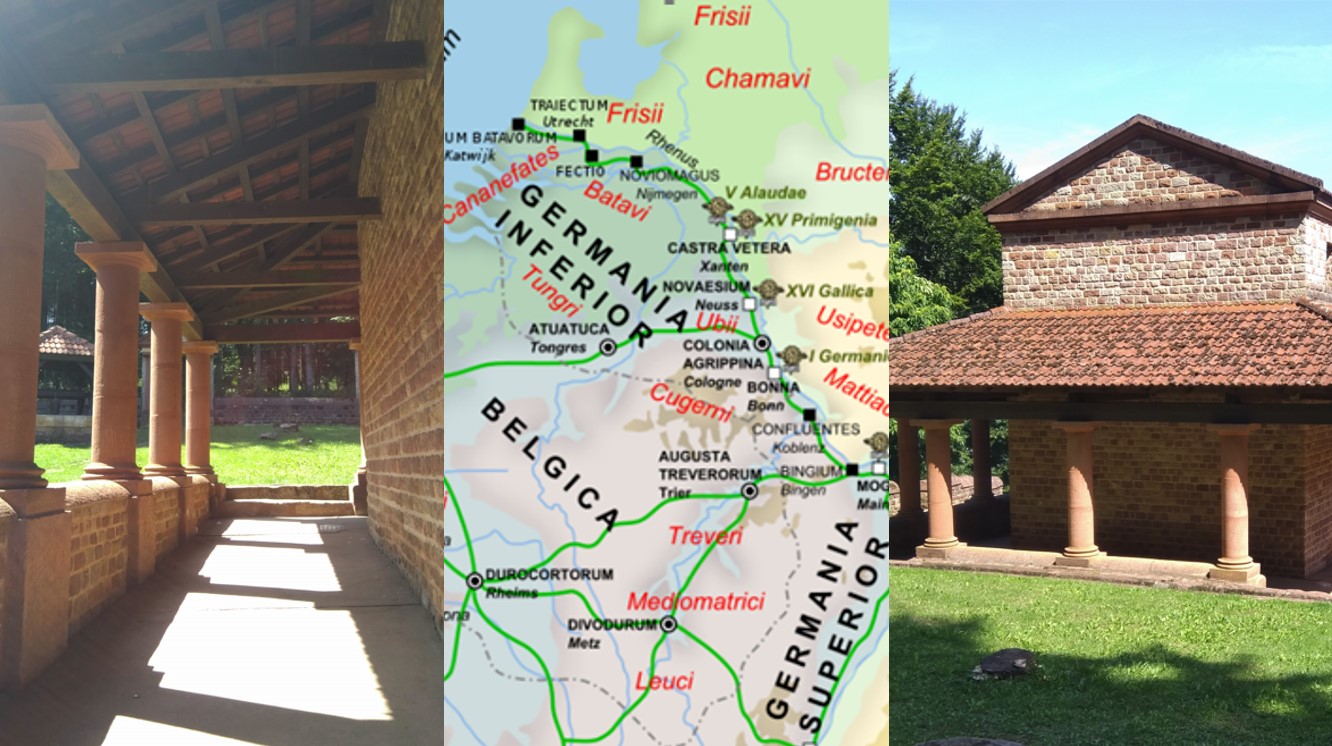 Gallo -Roman temple at Tawern, near to Trier – Augusta Treverorum , Germania Superior – photo MorganaTravelling along the Rhine into Germania Inferior (now modern day Netherlands) merchants on their way to Brittania could have easily visited the Nehallenia temple.Nehallenia revered todayIn recent years Nehallenia, Goddess of the Lowlands, has been rediscovered. Although the modern temple at Colijnsplaat was not designed as a ‘working temple’ it does attract devotees who make the pilgrimage there. Gallo -Roman temple at Tawern, near to Trier – Augusta Treverorum , Germania Superior – photo MorganaTravelling along the Rhine into Germania Inferior (now modern day Netherlands) merchants on their way to Brittania could have easily visited the Nehallenia temple.Nehallenia revered todayIn recent years Nehallenia, Goddess of the Lowlands, has been rediscovered. Although the modern temple at Colijnsplaat was not designed as a ‘working temple’ it does attract devotees who make the pilgrimage there.
Marjolein Makes on revisiting Colijnsplaat in September 2017. “So, on Mabon of that same year, we made the trek again. This time it was clear. I could feel the pull of the sea, connect to the land and the past in a way I never could before. Had experiences with other pagans and witches that I felt deeper within me than many before that. There was a feeling of ancientness, of primal and wildness, that I had been seeking my entire path, but hadn’t been able to find. I found it there. I found it with Nehalennia.”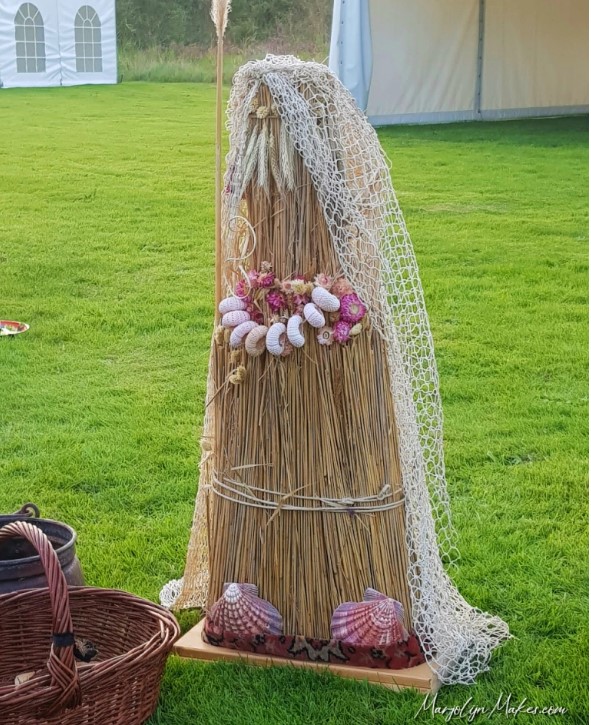 A modern devotion; Nehalennia statue at the harvest festival Marjolein Makes.References A modern devotion; Nehalennia statue at the harvest festival Marjolein Makes.References
“Onbekend maakt onbemind – Nehalennia van Zeeland en de onzichtbare vrouwen om haar heen.”
Annine van der Meer, February 2016, reworked September 2016.
Dr Annine E. G. van der Meer is a historian of religion, theologian and symbol expert. She wrote a number of authoritative books about forgotten women from women’s history, www.anninevandermeer.nl
I am indebted to Annine for this essay which I have used extensively here in an English version.
For the Dutch version:
docplayer.nl/46006148-Onbekend-maakt-onbemind-nehalennia-van-zeeland-en-de-onzichtbare-vrouwen-om-haar-heen.html
and pdf: www.annine-pansophia.nl/annine_van_der_meer/wp-content/uploads/Onbekend-maakt-onbemind.-Nehalennia-van-Zeeland-en-de-onzichtbare-vrouwen-herbew-sept-2016.pdf
Dr. Annine E.G. van der Meer, ‘Nieuw licht op Nehallenia’: Nederlands, Paperback ISBN 9789082031324, Druk: 1, maart 2015 See the review.
Nehallenia Godin van de zeekust: Gardenstone – Nederlands boudicca.de/ See the review.
(links all accessed July 2021)
Meaning of the name Nehallenia: www.nemokennislink.nl/publicaties/het-raadsel-van-nehalennia-ontrafeld/
Nehallenia: www.livius.org/articles/religion/nehalennia/
For clearer images go to: www.livius.org/pictures/netherlands/colijnsplaat/votive-to-nehalennia-4/
Nehallenia-altaar met staande Nehalennia en haar hond, anonymus 1715
www.rijksmuseum.nl/en/collection/RP-P-OB-75.164
Drawing: The discovery of a Nehalennia temple in Domburg. 19th Century drawing after a sketch from 1647) nl.wikipedia.org/wiki/Nehalennia_(godin)#/media/Bestand:Nehalennia_Domburg.jpg
Reconstructie van de tempel op Colijnsplaat: nl.wikipedia.org/wiki/Nehalennia_(godin)#/media/Bestand:Tempel_van_Nehalennia_Colijnsplaat_(2).JPG
nl.wikipedia.org/wiki/Nehalennia_(godin)#/media/Bestand:Nehalennia_Domburg.jpg
Nehalennia in brons, Guido Metsers 1989 : nl.wikipedia.org/wiki/Guido_Metsers
Archeon, reconstructed Roman temple, from Cuijk:
leukefeesten.nl/feestlocatie/alphen-aan-den-rijn/archeon/#&gid=1&pid=1
Matronensteen: vici.org/vici/16496/
BLOG: NEHALENNIA, EEN ZEEUWSE GODIN
Image of the Goddess, limestone 82 cms/ Beeld van de godin, kalksteen, 82 cm. Rijksmuseum van Oudheden Leiden
nl.wikipedia.org/wiki/Nehalennia_(godin)#/media/Bestand:Leiden-Nehalennia-statue.JPG
A modern interpretation; Nehalennia statue at the harvest festival:
marjolijnmakes.com/2021/01/10/finding-nehalennia/ .About Morgana"Morgana is Anglo/Dutch and lives in the Netherlands. She is a practising Gardnerian HPS. Over the years, she has facilitated a variety of Wiccan groups. She is co-editor of the international and bilingual "Wiccan Rede" magazine, which was launched in 1980 and is coordinator of Silver Circle, a Wiccan network in the Netherlands. As International Coordinator for PFI she travels extensively giving talks and workshops about Wicca and Paganism." Source: wiccanrede.org/ article: wiccanrede.org/2021/08/nehalennia-goddess-of-the-lowlands/ |
|
|
|
Post by pieter on Jan 14, 2022 8:10:46 GMT -7
Goddess Nehalennia  Some Pagan people, most often Pagan female Wicca's worship the Goddess Nehelenia Some Pagan people, most often Pagan female Wicca's worship the Goddess Nehelenia Some Pagan people, most often Pagan female Wicca's worship the Goddess NeheleniaNehalennia and tulips Some Pagan people, most often Pagan female Wicca's worship the Goddess NeheleniaNehalennia and tulips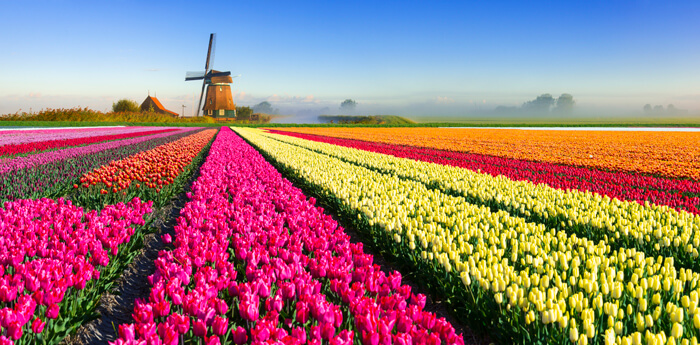 Because Nehalennia is a dutch deity and the Netherlands is the largest producer of tulip flowers, it's natural that people assume tulips are related to Nehalennia. Because Nehalennia is a dutch deity and the Netherlands is the largest producer of tulip flowers, it's natural that people assume tulips are related to Nehalennia.
In fact, tulips are not native of the Netherlands, but Central Asian and Turkey, and were introduced in the Netherlands in 1593.
The name of Nehalennia was unknown until 1647 when the archaeological finds revealed that Nehalennia was worshipped in the first centuries A.D.
Of course, tulips can be offered to Nehalennia, but it does not mean it's an ancient tradition. Some Pagan people, most often Pagan female Wicca's worship the Goddess Nehelenia Some Pagan people, most often Pagan female Wicca's worship the Goddess Nehelenia Some Pagan people, most often Pagan female Wicca's worship the Goddess Nehelenia Some Pagan people, most often Pagan female Wicca's worship the Goddess Nehelenia Some Pagan people, most often Pagan female Wicca's worship the Goddess Nehelenia Some Pagan people, most often Pagan female Wicca's worship the Goddess Nehelenia Some Pagan people, most often Pagan female Wicca's worship the Goddess Nehelenia. Female and Male Wicca's at a Zeelandic Beach during a Pagan Nehelenia ceremony in Zeeland Some Pagan people, most often Pagan female Wicca's worship the Goddess Nehelenia. Female and Male Wicca's at a Zeelandic Beach during a Pagan Nehelenia ceremony in Zeeland A Male witch or Wicca during a Pagan Nehelenia ceremony in Zeeland on a Beach A Male witch or Wicca during a Pagan Nehelenia ceremony in Zeeland on a Beach Some Pagan people, most often Pagan female Wicca's worship the Goddess Nehelenia Some Pagan people, most often Pagan female Wicca's worship the Goddess Nehelenia A staw sculpture which symbolises the Goddess Nehelenia on a Zeelandic Beach A staw sculpture which symbolises the Goddess Nehelenia on a Zeelandic Beach Some Pagan people, most often Pagan female Wicca's worship the Goddess NeheleniaThe Temple of NehalenniaTo me, one of the most interesting facts about Nehalennia is that she has a temple, even not being a popular goddess. Some Pagan people, most often Pagan female Wicca's worship the Goddess NeheleniaThe Temple of NehalenniaTo me, one of the most interesting facts about Nehalennia is that she has a temple, even not being a popular goddess.
Archaeological finds attested that in ancient times, Nehalennia had at least two temples which were situated on the coast of the province of Zealand in the Netherlands.
It’s believed that before being adopted by the Romans, Nehalennia was worshipped in groves and the original temples were built in those groves.
In 2005, a replica of a Gallo-Roman temple in honor of Nehalennia was built in Colijnsplaat.
In modern worship, near the temple, Spring and Fall festivals are held in honor of Nehalennia. Some Pagan people, most often Pagan female Wicca's worship the Goddess Nehelenia Some Pagan people, most often Pagan female Wicca's worship the Goddess Nehelenia Some Pagan people, most often Pagan female Wicca's worship the Goddess Nehelenia Some Pagan people, most often Pagan female Wicca's worship the Goddess Nehelenia Some Pagan people, most often Pagan female Wicca's worship the Goddess Nehelenia Some Pagan people, most often Pagan female Wicca's worship the Goddess Nehelenia Some Pagan people, most often Pagan female Wicca's worship the Goddess Nehelenia Some Pagan people, most often Pagan female Wicca's worship the Goddess Nehelenia Some Pagan people, most often Pagan female Wicca's worship the Goddess Nehelenia Some Pagan people, most often Pagan female Wicca's worship the Goddess Nehelenia Some Pagan people, most often Pagan female Wicca's worship the Goddess Nehelenia Some Pagan people, most often Pagan female Wicca's worship the Goddess Nehelenia Some Pagan people, most often Pagan female Wicca's worship the Goddess Nehelenia Some Pagan people, most often Pagan female Wicca's worship the Goddess Nehelenia Some Pagan people, most often Pagan female Wicca's worship the Goddess Nehelenia Some Pagan people, most often Pagan female Wicca's worship the Goddess Nehelenia Some Pagan people, most often Pagan female Wicca's worship the Goddess Nehelenia Some Pagan people, most often Pagan female Wicca's worship the Goddess Nehelenia Some Pagan people, most often Pagan female Wicca's worship the Goddess Nehelenia Some Pagan people, most often Pagan female Wicca's worship the Goddess Nehelenia Some Pagan people, most often Pagan female Wicca's worship the Goddess Nehelenia Some Pagan people, most often Pagan female Wicca's worship the Goddess Nehelenia Some Pagan people, most often Pagan female Wicca's worship the Goddess Nehelenia Some Pagan people, most often Pagan female Wicca's worship the Goddess Nehelenia Some Pagan people, most often Pagan female Wicca's worship the Goddess Nehelenia Some Pagan people, most often Pagan female Wicca's worship the Goddess Nehelenia Some Pagan people, most often Pagan female Wicca's worship the Goddess Nehelenia Some Pagan people, most often Pagan female Wicca's worship the Goddess Nehelenia Some Pagan people, most often Pagan female Wicca's worship the Goddess Nehelenia Some Pagan people, most often Pagan female Wicca's worship the Goddess Nehelenia Some Pagan people, most often Pagan female Wicca's worship the Goddess Nehelenia Some Pagan people, most often Pagan female Wicca's worship the Goddess Nehelenia Some Pagan people, most often Pagan female Wicca's worship the Goddess Nehelenia Some Pagan people, most often Pagan female Wicca's worship the Goddess Nehelenia Some Pagan people, most often Pagan female Wicca's worship the Goddess Nehelenia Some Pagan people, most often Pagan female Wicca's worship the Goddess Nehelenia Some Pagan people, most often Pagan female Wicca's worship the Goddess Nehelenia Some Pagan people, most often Pagan female Wicca's worship the Goddess Nehelenia Some Pagan people, most often Pagan female Wicca's worship the Goddess Nehelenia Some Pagan people, most often Pagan female Wicca's worship the Goddess Nehelenia Some Pagan people, most often Pagan female Wicca's worship the Goddess Nehelenia Some Pagan people, most often Pagan female Wicca's worship the Goddess Nehelenia Some Pagan people, most often Pagan female Wicca's worship the Goddess Nehelenia Some Pagan people, most often Pagan female Wicca's worship the Goddess Nehelenia Some Pagan people, most often Pagan female Wicca's worship the Goddess Nehelenia Some Pagan people, most often Pagan female Wicca's worship the Goddess Nehelenia Some Pagan people, most often Pagan female Wicca's worship the Goddess Nehelenia Some Pagan people, most often Pagan female Wicca's worship the Goddess Nehelenia Some Pagan people, most often Pagan female Wicca's worship the Goddess Nehelenia Some Pagan people, most often Pagan female Wicca's worship the Goddess Nehelenia Some Pagan people, most often Pagan female Wicca's worship the Goddess Nehelenia Some Pagan people, most often Pagan female Wicca's worship the Goddess Nehelenia Some Pagan people, most often Pagan female Wicca's worship the Goddess Nehelenia Some Pagan people, most often Pagan female Wicca's worship the Goddess Nehelenia Some Pagan people, most often Pagan female Wicca's worship the Goddess Nehelenia Some Pagan people, most often Pagan female Wicca's worship the Goddess Nehelenia Some Pagan people, most often Pagan female Wicca's worship the Goddess Nehelenia Some Pagan people, most often Pagan female Wicca's worship the Goddess Nehelenia Some Pagan people, most often Pagan female Wicca's worship the Goddess Nehelenia Some Pagan people, most often Pagan female Wicca's worship the Goddess Nehelenia Some Pagan people, most often Pagan female Wicca's worship the Goddess Nehelenia Some Pagan people, most often Pagan female Wicca's worship the Goddess Nehelenia Some Pagan people, most often Pagan female Wicca's worship the Goddess Nehelenia Some Pagan people, most often Pagan female Wicca's worship the Goddess Nehelenia Some Pagan people, most often Pagan female Wicca's worship the Goddess Nehelenia Some Pagan people, most often Pagan female Wicca's worship the Goddess Nehelenia The Goddess Nehelenia with her dog The Goddess Nehelenia with her dog Nehelenia altars in the National Museum of Antiquities, Leiden, South-Holland Province, the Netherlands Nehelenia altars in the National Museum of Antiquities, Leiden, South-Holland Province, the Netherlands The Priestess who runs the Nehelenia Facebook page www.facebook.com/goddessnehalennia/ The Priestess who runs the Nehelenia Facebook page www.facebook.com/goddessnehalennia/ The Priestess who runs the Nehelenia Facebook page www.facebook.com/goddessnehalennia/ The Priestess who runs the Nehelenia Facebook page www.facebook.com/goddessnehalennia/
|
|
|
|
Post by pieter on Jan 14, 2022 9:00:47 GMT -7
2018 Nehalennia's Fest in Colijnsplaat, Noord Beveland (region), Zeeland (Province), the Netherlands, Easterscheldt                           A Pagan (Heathen) ceremony for the "Zeeland" Goddess and deity Nehalenia at the Nehelenia temple in Colijnsplaat (Town), Noord Beveland (region) in Zeeland Province in the Netherlands A Pagan (Heathen) ceremony for the "Zeeland" Goddess and deity Nehalenia at the Nehelenia temple in Colijnsplaat (Town), Noord Beveland (region) in Zeeland Province in the Netherlands A Pagan (Heathen) ceremony for the "Zeeland" Goddess and deity Nehalenia outside and inside the Nehelenia temple in Colijnsplaat (Town), Noord Beveland (region) in Zeeland Province in the Netherlands A Pagan (Heathen) ceremony for the "Zeeland" Goddess and deity Nehalenia outside and inside the Nehelenia temple in Colijnsplaat (Town), Noord Beveland (region) in Zeeland Province in the Netherlands A Pagan (Heathen) ceremony for the "Zeeland" Goddess and deity Nehalenia outside the Nehelenia temple in Colijnsplaat (Town), Noord Beveland (region) in Zeeland Province in the Netherlands A Pagan (Heathen) ceremony for the "Zeeland" Goddess and deity Nehalenia outside the Nehelenia temple in Colijnsplaat (Town), Noord Beveland (region) in Zeeland Province in the Netherlands A fire at the beach after the Nehelenia Fest and Nehelenia Goddess and deity Pagan (heathen) Wicca ceremony at the Nehelenia Temple in Colijnsplaat in 2018Folks, A fire at the beach after the Nehelenia Fest and Nehelenia Goddess and deity Pagan (heathen) Wicca ceremony at the Nehelenia Temple in Colijnsplaat in 2018Folks,
I was invited by Rabia Karaman, a kind and intelligent and professional Turkish Dutch Muslim political activist of the Denk (Think) migrant party ( en.wikipedia.org/wiki/DENK_(political_party) ) for a national gathering of religions on 21 Januari 2019, the day of my birthday, and went to the theatre and conference hall TivoliVredenburg in Utrecht, where representatives of religions and philosophies came together to talk about the tension and connection between believers and non-believers. The meeting was organized by In Vrijheid Ververbonden (Connected in Freedom), the national interfaith platform that champions democracy and religious freedom. I saw Roman-Catholic Priests, Orthodox christian priest of the Greek en Russian Orthodox churches in the Netherlands, Lutheran-, Methodist-, Baptist-, Evangelical christian ministers, Orthodox and Progressive rabbi's and representatives of secular Dutch Judaism, and I saw representatives of the Buddhist-, Hindu and Secular Humanist communities there and saw to my own surprise also representatives of the West Germanic Dutch Old Heathen Pagan faith in the Netherlands and representatives of the very tolerant and liberal faith, people of the Bahai community in the Netherlands.

The TivoliVredenburg is a contemporary music complex located in Utrecht, Netherlands. The venue consists of five halls designed acoustically for a specific music genre. Along with its hall, the venue also features an "amateur stage" and a cafe.

I was invited by the Dutch Turkish Rabia Karaman of the Denk party for the In Vrijheid Ververbonden (Connected in Freedom) meeting in TivoliVredenburg in Utrecht city

Rabia Karaman with princess Beatrix, the former Queen Beatrix
It was an amazing meeting to attend as a local journalist. I was invited due to my work for a local Broadcast Corporation (TV) and thus networks and connections with local city councillors. The lady who invited me had been interviewed by me and I invited her and her husband one saturday to come to my Monastry theme group Ruach to have a lecture on 'Islam and connection, being Muslim in the Netherlands'. I was proud of having been able to set up and organize that meeting in cooperation with my Muslim acqaintances and in fact friends. She, the Turkish Dutch lady and another Turkish Dutch city councillor were the first and amongst the first to reply to my fathers death. I may differ a lot with the opinions and policies of Denk, but I respect them in the sense of Freedom & Democracy and for the sake of pluriformity. They know my opinions and work and respect me and I respect them.
Cheers,
Pieter
|
|
|
|
Post by pieter on Jan 14, 2022 9:55:26 GMT -7
Ron, Karl, Jaga, Ludwik, Jeanne and John,
Have you every experienced Heathen Pagan religion, worship, fests, ceremonies or the presence of Pagan people in your environment. For some reason there are still these old West-Germanic, Northern Germanic Scandinavian and old Slavic Pagan religions, whichcraft, Wicca's, Witches and Heathen traditions, faiths, ceremonies, rituals and cultures around. Of course you know all that in the Western Christian faith some old Pagan medieval elements melted with Christianity and that the European christianity is not the Christianity of Christ and his Twelve or maybe more Apostles. The early Christianity of Palestine, Israel, Judea and Nazareth in Galilee, Bethlehem in Judea in the Westbank and Jerusalem on the Judaean mountains and the mountain ridge of Jerusalem, with it's Hebrew and Aramaic language and culture.
With Protestantism part of Christianity returned to it's old Hebrew roots, with new Bible translations in the National languages in staid of latin (Roman Catholic Chruch) and by being solely focussed on the Old Testament and New Testament and the prohibition in Calvinist Christianity of worship of sculptures, images, criticism of the Roman Catholic practice of indulgence. Indulgence is "a way to reduce the amount of punishment one has to undergo for sins", and a return to Jezus Christ as the centre without the Mary worship and worship of angels, holy priests and Bishops. Jezus christ is the centre and empty churches without sculptures or paintings, but often beautiful Protestant church architecture. The Bible, God and Jezus christ and the trinity became the focuspoint of Protestantism where in Roman Catholicism and the Eastern-Orthodox church old Pagan latin, Germanic and Slavic elements kept playing a role. In ancient Greek cult, kriophoros (Greek: κριοφόρος) or criophorus, the "ram-bearer," is a figure that commemorates the solemn sacrifice of a ram. It becomes an epithet of Hermes: Hermes Kriophoros. The early Christians adapted many elements of paganism. Ancient pagan funeral rituals often remained within Christian culture as aspects of custom and community with very little alteration. A type of song sung at death, the ritual lament, is one of the oldest of all art forms. As soon as death was imminent, the ritual began, then came the "struggle of the soul" and prayer for the dying. John Chrysostum gives a vivid account of the dying soul seeing angels and demons - "account books in hand" - struggling against each other in a contest for possession of the dying person's soul. Macarius of Egypt (fourth century) writes of such a contest which is only resolved by the intervention of the person's guardian angel - which is roughly parallel to Plato's daimon. In ancient Greek cult, kriophoros (Greek: κριοφόρος) or criophorus, the "ram-bearer," is a figure that commemorates the solemn sacrifice of a ram. It becomes an epithet of Hermes: Hermes Kriophoros. The early Christians adapted many elements of paganism. Ancient pagan funeral rituals often remained within Christian culture as aspects of custom and community with very little alteration. A type of song sung at death, the ritual lament, is one of the oldest of all art forms. As soon as death was imminent, the ritual began, then came the "struggle of the soul" and prayer for the dying. John Chrysostum gives a vivid account of the dying soul seeing angels and demons - "account books in hand" - struggling against each other in a contest for possession of the dying person's soul. Macarius of Egypt (fourth century) writes of such a contest which is only resolved by the intervention of the person's guardian angel - which is roughly parallel to Plato's daimon.
Spontaneous lamentation would break out among those present once the struggle of the soul was over. All evidence suggests this was a violent display of grief - the laceration of the cheeks, tearing one's hair, and the rending of garments along with the wailing of the lament song. The church saw this immoderate behavior as improper for people who believed death was not the end, so they attempted to moderate it by singing Psalms, with two groups of singers on opposite sides chanting an antiphonal lament, with rhythm, harmony and order instead. However, this too is similar to the pagan lament sung for Achilles and one suggested by Plato for his Examiners in the Laws.
Pagans and Jews decorated their burial chambers, so Christians did as well, thereby creating the first Christian art in the catacombs beneath Rome. This art is symbolic, rising out of a reinterpretation of Jewish and pagan symbolism. Christian piety infused the symbols with its own fresh interpretation. Christian art had something fundamentally new to say as it gave visual expression to the conviction that the human soul can be delivered from death to an everlasting life. Neither Judaism nor any pagan religion had previously made such a claim. "The Jewish faith puts little emphasis on immortality, and pagan beliefs about the afterlife were vague, uncertain, and sometimes dismal".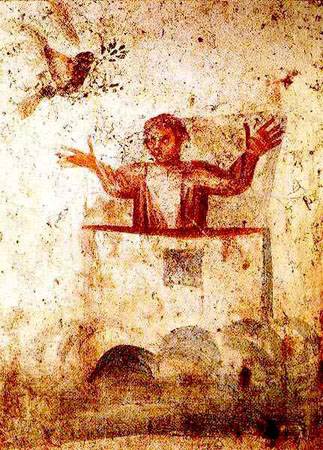 Noah catacomb (orans)While many new subjects appear for the first time in the Christian catacombs - i.e. the Good Shepherd, Baptism, and the Eucharistic meal - the Orant figures (women praying with upraised hands) probably came directly from pagan art. Pagan symbolism in the form of Victories, cupids, and shepherd scenes are scattered throughout the catacombs. Jewish and pagan use of sheep and goats, birds in a tree or vine, or eating fruit, especially grapes, seven steps leading up to a tomb, a pair of peacocks, the Robe of sanctity, the reading of scrolls, are all found in pagan art and adapted in the Christian art to express the hope of immortality in Christian terms. Pagan sarcophagi had long carried shells, and portraits of the dead often had shells over the head of the dead, while some put a shell over a grave. Christians and Jews adapted the convention, identifying it with another symbol - the halo. For the Christians who made the catacombs, these symbols were necessary to convey their message. Noah catacomb (orans)While many new subjects appear for the first time in the Christian catacombs - i.e. the Good Shepherd, Baptism, and the Eucharistic meal - the Orant figures (women praying with upraised hands) probably came directly from pagan art. Pagan symbolism in the form of Victories, cupids, and shepherd scenes are scattered throughout the catacombs. Jewish and pagan use of sheep and goats, birds in a tree or vine, or eating fruit, especially grapes, seven steps leading up to a tomb, a pair of peacocks, the Robe of sanctity, the reading of scrolls, are all found in pagan art and adapted in the Christian art to express the hope of immortality in Christian terms. Pagan sarcophagi had long carried shells, and portraits of the dead often had shells over the head of the dead, while some put a shell over a grave. Christians and Jews adapted the convention, identifying it with another symbol - the halo. For the Christians who made the catacombs, these symbols were necessary to convey their message.
Many previously pagan holy places were converted to Christian use. In 609 Pope Boniface IV obtained leave from the Byzantine Emperor Phocas to convert the Pantheon in Rome into a Christian church, a practice similar to that recommended eight years earlier by Pope Gregory I to Mellitus regarding Anglo-Saxon holy places, in order to ease the transition to Christianity. According to Willibald's Life of Saint Boniface, about 723, the missioner cut down the sacred Donar's Oak and used the lumber to build a church dedicated to St. Peter. Around 744, Saint Sturm established the monastery of Fulda on the ruins of a 6th-century Merovingian royal camp, destroyed 50 years earlier by the Saxons, at a ford on the Fulda River.
In its first three centuries, Christianity did not celebrate the birth of Christ. Birthdays were pagan, no one actually knew when Jesus was born, and many of the early church fathers objected to the whole idea. Once it finally was celebrated, it was on the sixth of January, not December 25. The earliest source stating December 25 as the date of birth of Jesus was Hippolytus of Rome (170–236), writing very early in the 3rd century, based on the assumption that the conception of Jesus took place at the Spring equinox which he placed on March 25, and then added nine months. By the year 354, December 25 as the birth date of Christ is found in a Roman calendar where it is not identified as a church feast, but is recorded as if December 25 had become the actual birth date as a historical fact. Theological themes and calculations may explain why the church eventually adopted a celebration of Jesus' birth, but not why December the 25th was chosen as the date. Historian Stephen Nissenbaum says this choice was a compromise.[124] There is no avoiding "Roman midwinter parties and Christianity's conscious decision to place a Christmas celebration right in the middle of them" as part of that compromise.
The Roman cult of Sol had existed since the early Republic, and it was celebrated on 25 December. In AD 274, the Roman emperor Aurelian made it an official cult alongside the other traditional Roman cults. Saturnalia was an ancient Roman festival in honour of the god Saturn, held on 17 December of the Julian calendar and later expanded to 23 December. The popularity of Saturnalia continued into the 3rd and 4th centuries, and as the Roman Empire came under Christian influence, many of its customs were recast into or at least influenced the seasonal celebrations surrounding Christmas and the New Year. Many observers schooled in the classical tradition have noted similarities between the Saturnalia and historical revelry during the Twelve Days of Christmas and the Feast of Fools William Warde Fowler notes: "[Saturnalia] has left its traces and found its parallels in great numbers of medieval and modern customs, occurring about the time of the winter solstice."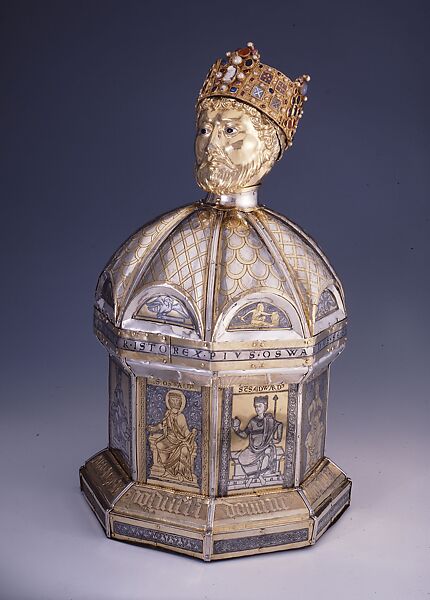 Reliquary of St. Oswald, Hildesheim, Hildesheim, Lower Saxony (Niedersachsen), in Northern Germany Reliquary of St. Oswald, Hildesheim, Hildesheim, Lower Saxony (Niedersachsen), in Northern Germany
|
|
|
|
Post by Jaga on Jan 14, 2022 11:23:11 GMT -7
Hello Pieter,
here in Idaho we had a summer solstice celebration according to Swedish traditions in New Sweden. They erect a big pole and decorate it with flowers.
When I was a girl in Poland we did Marzanna - burning the straw puppet in river. I also remember to participate in Santa Lucia celebration - light parade of young girls. There are plenty of beautiful pagan traditions here and there, some were incorporated in the Christian traditions also.
|
|
|
|
Post by pieter on Jan 14, 2022 14:58:57 GMT -7
|
|

